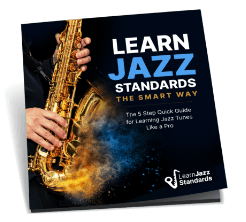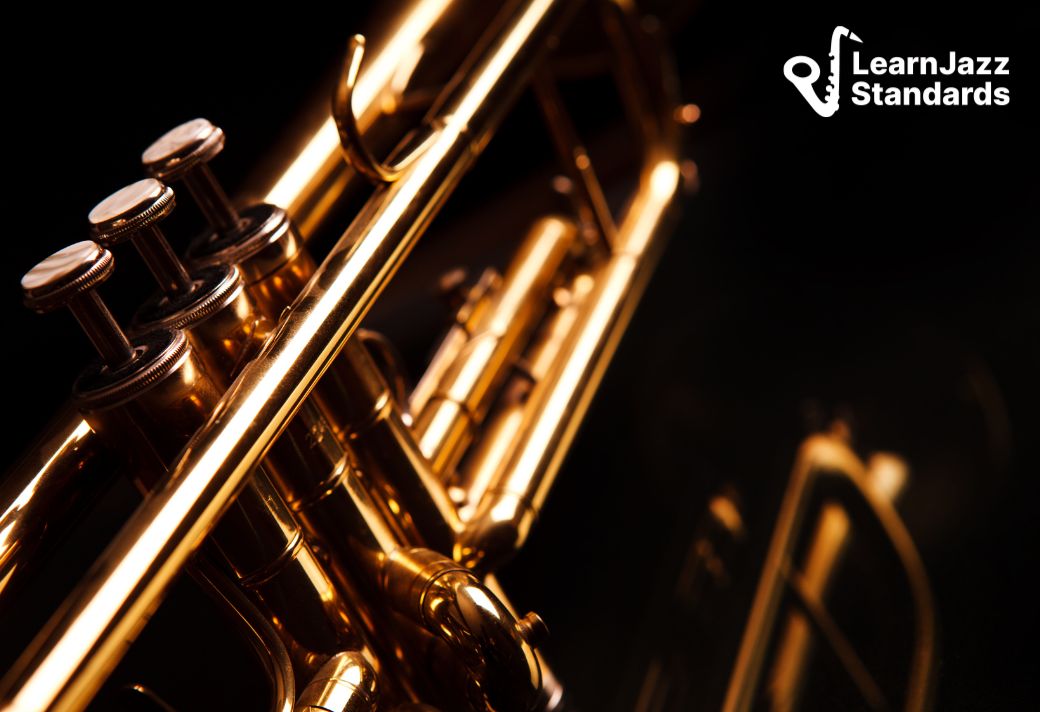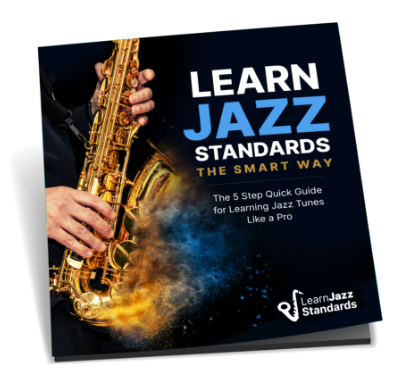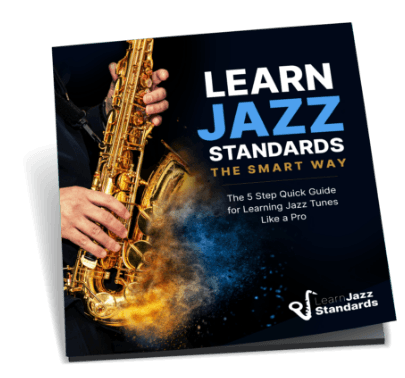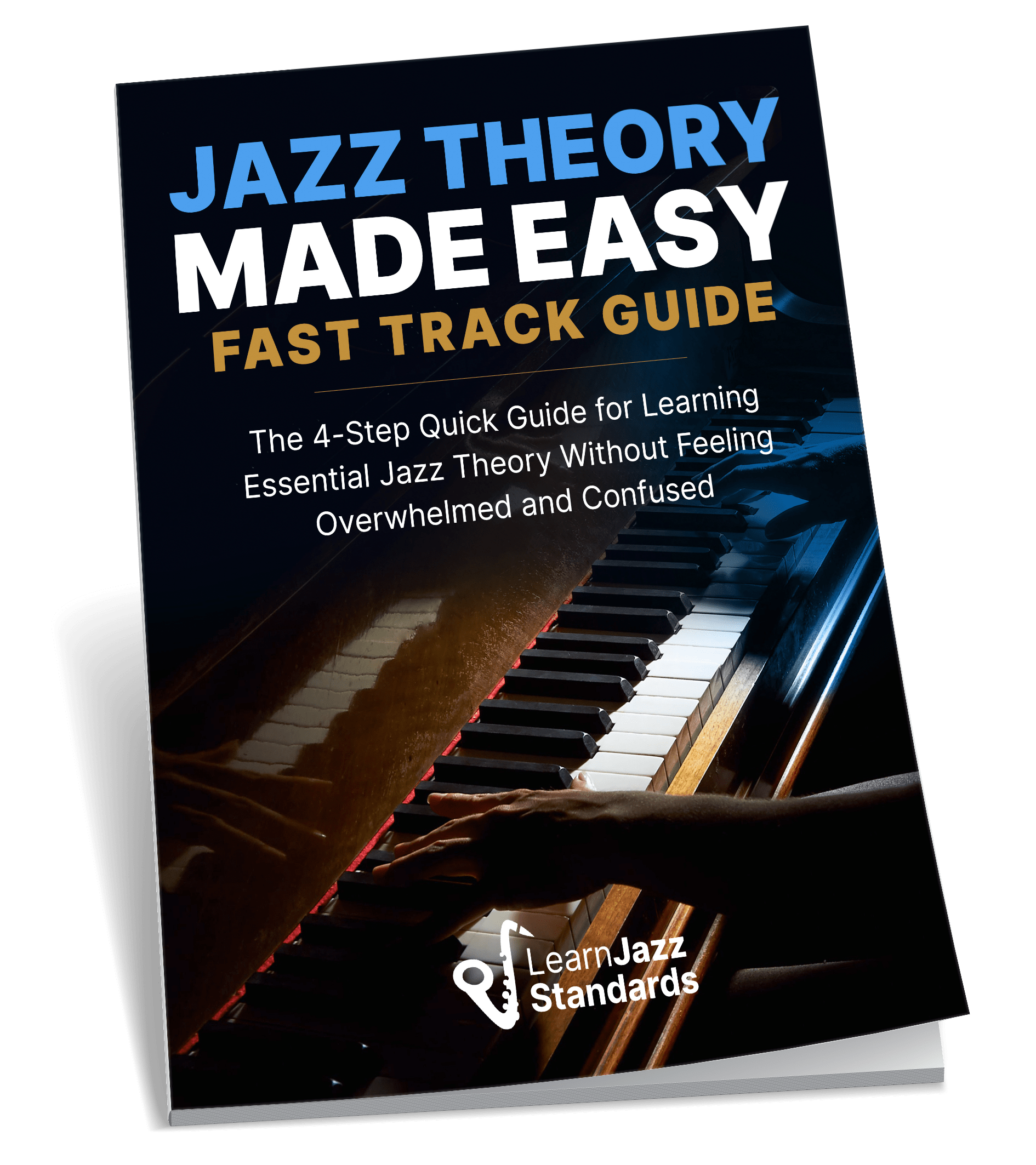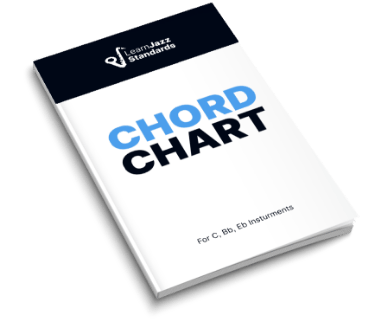If you are interested in learning jazz, you’ll eventually come to this burning question—what are the best jazz albums of all time? Obviously, the answers to this question depend on many, many factors. However, there are specific jazz albums that everyone interested in jazz needs to hear.
We’ve compiled 30 of the best jazz albums of all time, so you can start listening to these seminal statements of jazz mastery! If you are serious about learning jazz and ready to take the next step in your jazz music education, check out the Learn Jazz Standards Inner Circle.
The Inner Circle has incredible jazz education resources designed to help you break through practice plateaus and take your playing and musicianship to the next level!
Improve in 30 Days or Less. Join the Inner Circle.
Table of Contents
How We Determined the “Best Jazz Albums of All Time?”
How do you quantify best?
Claiming that we know which jazz albums are best is bold. In reality, there isn’t an objective way to measure which jazz albums are the best. Sure, you can look at record sales or Billboard charts to determine which albums performed the most successfully according to one metric or another.
However, jazz is art, and art is ultimately subjective. What we can do, however, is compile a list of jazz albums that we think anyone interested in the genre needs to hear. The 30 albums in this list are essential for a variety of reasons.
What Makes These “The Best Jazz Albums of All Time?”
All are groundbreaking and influential within and outside of the jazz world. Whether released fifty years ago or fifteen years ago, each jazz album contributed to the proliferation of jazz music and helped evangelize the genre.
Essentially, these albums helped further the jazz tradition in some way during the eras in which they were released.
Some of these albums were controversial when released and only became appreciated after publication. Others are examples of artists fusing jazz with other genres and breathing new life into the tradition, such as classical music or Afro-Cuban music.
Others came to define an era of jazz history, serving as the poster child for jazz fusion, free jazz, or cool jazz. One thing is certain, however. If you listen to this jazz collection, you will better understand and appreciate jazz’s scope and influence on the world.
That is ultimately our goal with this list—to take you on a journey through the best jazz offers while also painting a picture of jazz’s evolution from big bands and swing to electronic music.
The Best Jazz Has To Offer (In No Particular Order)
A final note before diving into the best jazz albums of all time—because we are considering the impact and importance of these albums to the development of jazz, this list isn’t in a ranking order. These classic jazz albums have had an essential role in the music, and ranking them is a fool’s errand.
With that settled, let’s dig into the best jazz albums of all time.
1. Miles Davis – Kind of Blue (1959)
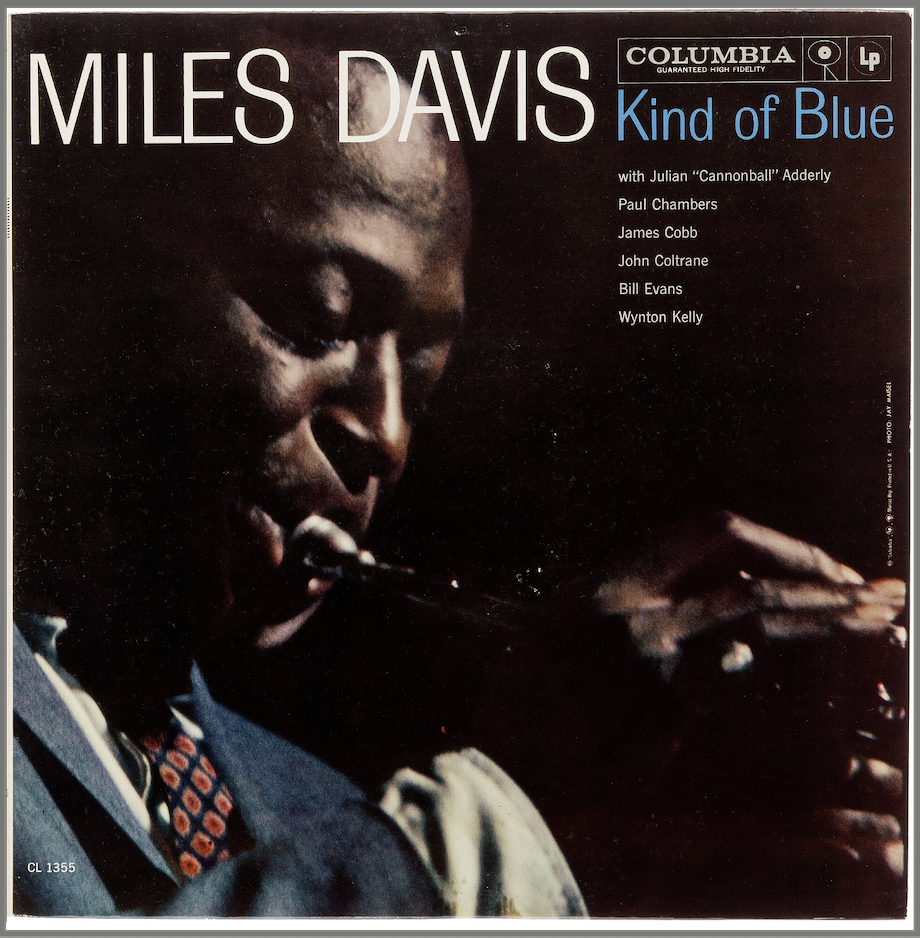
image source: Wikipedia
- Miles Davis – Trumpet
- John Coltrane – Tenor Saxophone
- Julian “Cannonball” Adderley – Alto Saxophone
- Bill Evans – Piano (most tracks)
- Wynton Kelly – Piano on “Freddie Freeloader”
- Paul Chambers – Bass
- Jimmy Cobb – Drums
Kind of Blue was recorded over two sessions in 1959 at Columbia Records’ 30th Street Studio in New York City. The first session took place on March 2, recording “So What,” “Freddie Freeloader,” and “Blue in Green.” The second session on April 22 completed the album with “All Blues” and “Flamenco Sketches.”
- So What
- Freddie Freeloader
- Blue in Green
- All Blues
- Flamenco Sketches
Reception and Impact
The album was another example of Davis’ interest in modal jazz, a style focused on exploring the harmony of one scale or mode rather than the typical jazz chord progressions of the Bebop era. For more on modal jazz, check out this article on 5 Must-Know Modal Jazz tunes.
Miles Davis’ approach for Kind of Blue was to keep the compositions minimal, only giving the musicians basic sketches, allowing them to fill in the blank with their musicianship and intuition. This recording style led to a fluid and almost effortless sound throughout the album.
Upon release, Kind of Blue was met with critical acclaim and has since been considered one of the greatest jazz albums ever.
It remains one of the best-selling jazz records, having sold over four million copies worldwide since its release. It has also been added to the Library of Congress’s National Recording Registry. So, if your metric is commercial success, it is one of the best jazz albums of all time.
Why It’s On This List
The album’s modal jazz approach has had a profound influence not only on jazz but also on rock acts, classical music, and other genres. Musicians like John Coltrane and Bill Evans further explored modal jazz in their endeavors. This album would kickstart the career of bassist Paul Chambers.
Also, Kind of Blue is known for significantly influencing other artists outside of jazz, such as rock guitarist Jimi Hendrix and the rock band Pink Floyd.
Its impact has extended far beyond jazz. Kind of Blue is considered one of the greatest albums ever recorded, let alone the greatest jazz album ever recorded.
source: Wikipedia
2. John Coltrane – A Love Supreme (1965)
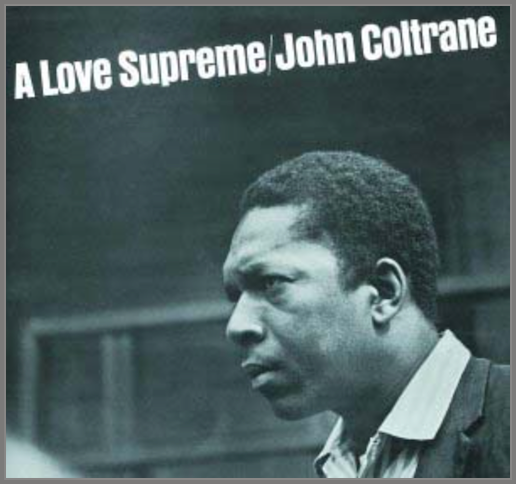
image source: Wikipedia
- John Coltrane – Tenor Saxophone
- McCoy Tyner – Piano
- Jimmy Garrison – Bass
- Elvin Jones – Drums
A Love Supreme was recorded in a single session on December 9, 1964, at Van Gelder Studio in Englewood Cliffs, New Jersey, and released by Impulse Records in 1965.
The album is structured as a four-part suite: “Acknowledgement,” “Resolution,” “Pursuance,” and “Psalm.”
A Love Supreme was a profoundly spiritual work for John Coltrane. Some interpreted the work as the artist’s acknowledgment that his talents come from a higher spiritual power. His liner notes explicitly dedicate the album to God, making it not just a musical statement but a spiritual declaration.
The album blends elements of modal jazz with avant-garde influences.
- Acknowledgment
- Resolution
- Pursuance
- Psalm
Reception and Impact
Upon its release, A Love Supreme received critical acclaim and has since been hailed as one of the greatest jazz albums ever.
The album has appeared on many “greatest albums” lists, including Rolling Stone’s list of the 500 greatest albums of all time, where it was ranked No. 47 in 2003, No. 66 in 2020, and inducted into the National Recording Registry.
The suite’s influence extended beyond jazz, inspiring musicians in genres as diverse as rock and spiritual music. Artists like Carlos Santana and Bono of U2 have cited this John Coltrane album as a deep source of inspiration.
Why It’s On The List
A Love Supreme is a high point in John Coltrane’s discography and a milestone in jazz history. It solidified John Coltrane’s reputation as a spiritual jazz pioneer, inspiring a generation of musicians to explore introspective themes in their compositions.
source: Wikipedia
3. John Coltrane – Giant Steps (1960)
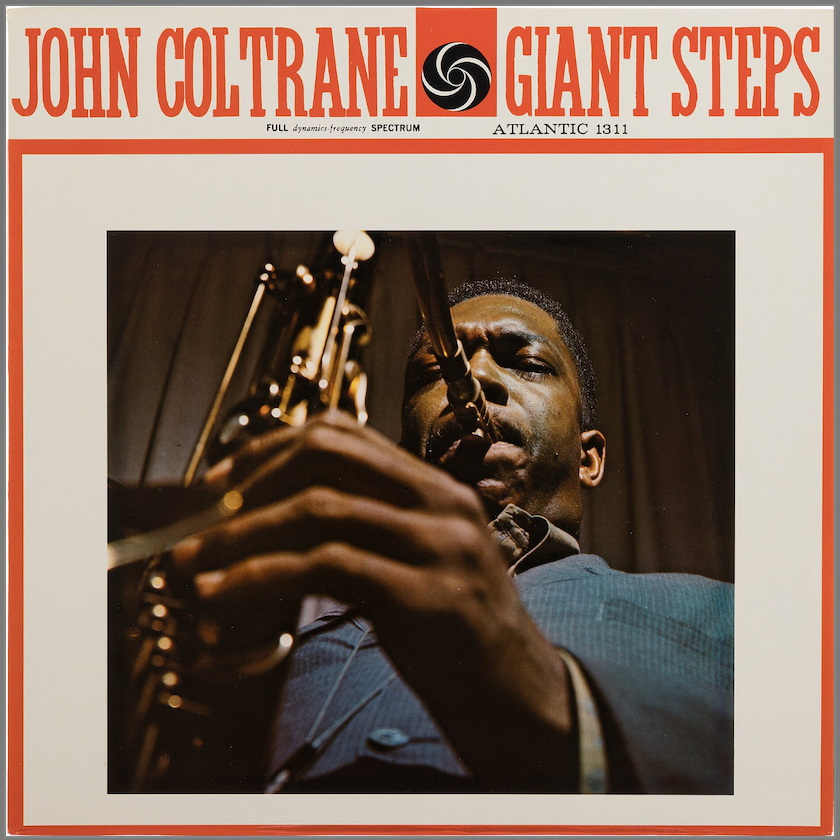
image source: Wikipedia
- John Coltrane – Tenor Saxophone
- Tommy Flanagan – Piano (majority of tracks)
- Wynton Kelly – Piano on “Naima”
- Paul Chambers – Bass
- Art Taylor – Drums
- Jimmy Cobb – Drums on “Naima”
Released in February 1960, Giant Steps is a milestone album in jazz history and John Coltrane’s first album as a leader for Atlantic Records.
It marks a turning point in John Coltrane’s career. It was his first to feature all original compositions, exploring new chord progressions that eventually became “Coltrane changes”—a complex series of chord progressions that feature tonal centers moving in major thirds.
Check out this article if you want to understand Coltrane changes better.
It was recorded over several sessions in 1959, during the same period as John Coltrane’s work on Kind of Blue with Miles Davis.
- Giant Steps
- Cousin Mary
- Countdown
- Spiral
- Syeeda’s Song Flute
- Naima
- Mr. P.C.
Reception and Impact
Giant Steps received a mixed reception upon release, as some critics found its technical complexity challenging. However, it is now considered one of the most influential jazz albums ever recorded.
The title track, “Giant Steps,” is famous for its rapid tempo and intricate chord changes, making it a “rite of passage” for jazz musicians. Along with the title track, John Coltrane’s compositions “Naima” and “Mr. P.C.” became jazz standards.
Learn more about John Coltrane and his compositions by checking out our article on the 37 Best Jazz Saxophonists.
Why It’s On This List
Giant Steps is credited with pushing the boundaries of jazz improvisation and composition, influencing jazz musicians and other genres. This album is significant in the history of jazz as an improvisational music.
The album’s harmonic innovations, particularly “Coltrane Changes,” redefined what was possible in jazz improvisation.
source: Wikipedia
4. Wayne Shorter – Speak No Evil (1966)
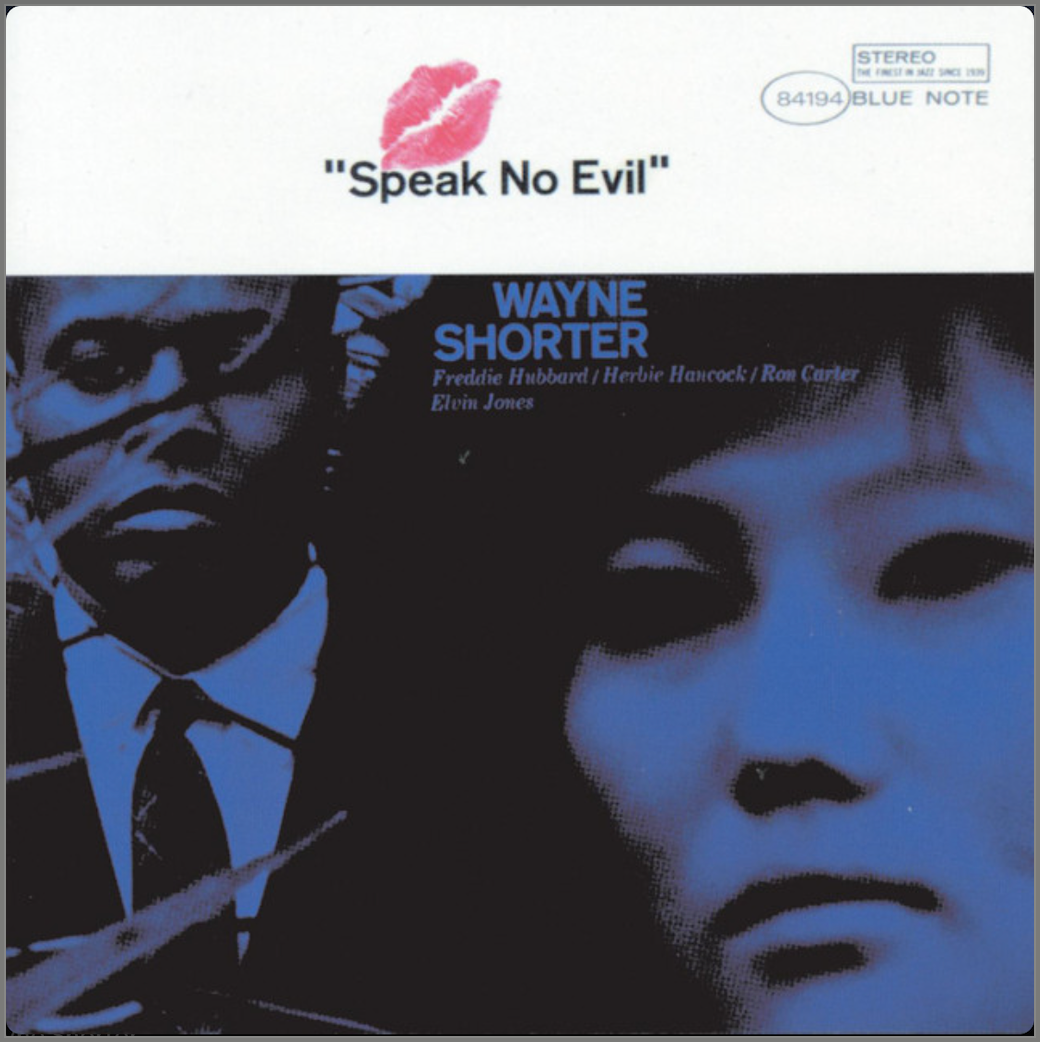
image source: Wikipedia
- Wayne Shorter – Tenor Saxophone
- Freddie Hubbard – Trumpet
- Herbie Hancock – Piano
- Ron Carter – Bass
- Elvin Jones – Drums
It’s time for one of my personal favorites! If this were purely a personal list and I wasn’t considering larger impacts on the music world, this might be my number one in the rankings for best jazz albums of all time.
Speak No Evil was recorded on December 24, 1964, and released in 1966 by Blue Note Records. It is considered one of Wayne Shorter’s most important works and an excellent example of a quintessential Blue Note Album.
The album stylistically blends hard bop, post-bop, and modal jazz elements and showcases Shorter’s evolving compositional style. It features a lineup that includes members of Miles Davis’s mid-1960s quintet, recorded during his mid-1960s tenure with Miles Davis.
Shorter wrote each of the six tracks on the album. His unconventional chord progressions and rich, non-diatonic chords give these compositions a haunting, airy quality.
- Witch Hunt
- Fee-Fi-Fo-Fum
- Dance Cadaverous
- Speak No Evil
- Infant Eyes
- Wild Flower
Reception and Impact
Critics and listeners have lauded the album for its haunting beauty, calling it a cohesive masterpiece that solidifies Wayne Shorter’s standing as a top saxophonist and composer.
Speak No Evil is considered an essential jazz recording featured in various “best jazz albums of all time” lists, showcasing its lasting impact on the genre.
Why It’s On The List
Speak No Evil is a bonafide jazz album. It reflects Wayne Shorter’s unique approach to jazz composition and incredible improvisational instinct. It is a timeless piece of jazz history and an album that is just as important today as it was sixty years ago.
5. The Dave Brubeck Quartet – Time Out (1959)
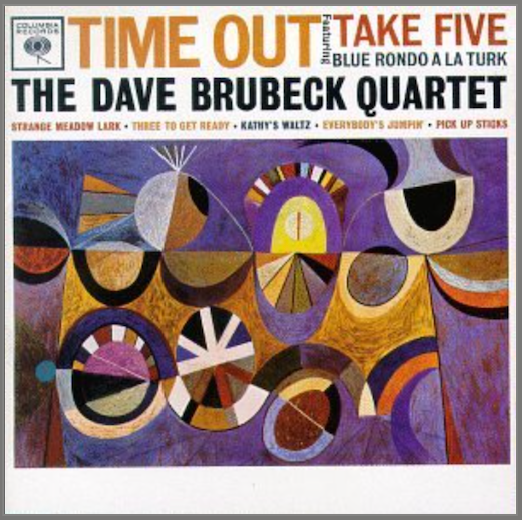
image source: Wikipedia
- Dave Brubeck – Piano
- Paul Desmond – Alto Saxophone
- Eugene Wright – Bass
- Joe Morello – Drums
Released in 1959 by Columbia Records, Time Out became one of the most commercially successful jazz albums in history, and that’s why we are including it on our list.
In addition to being extremely important for ushering in a whole new generation of jazz fans, this album is notable for its use of unconventional time signatures, including 5/4 (Take Five) and 9/8 (Blue Rondo à la Turk).
- Blue Rondo à la Turk
- Strange Meadow Lark
- Take Five
- Three to Get Ready
- Kathy’s Waltz
- Everybody’s Jumpin’
- Pick Up Sticks
Reception and Impact
Initially, Time Out received mixed reviews but achieved massive commercial success, reaching No. 2 on the Billboard Pop Albums chart. Time Out was the first jazz album to sell over a million copies and was certified double platinum.
Additionally, “Take Five” became the first jazz single to sell over a million copies and reached No. 25 on the Billboard Pop Singles chart, which is rare for a jazz song.
Why It’s on the List
Its success and innovative approach solidified the Dave Brubeck Quartet’s place in jazz history. They showcased that complex musical ideas could achieve mainstream popularity. Because of this, Time Out created a new generation of jazz fans and served as a gateway album into the genre.
source: Wikipedia
6. Wes Montgomery – The Incredible Jazz Guitar of Wes Montgomery (1960)
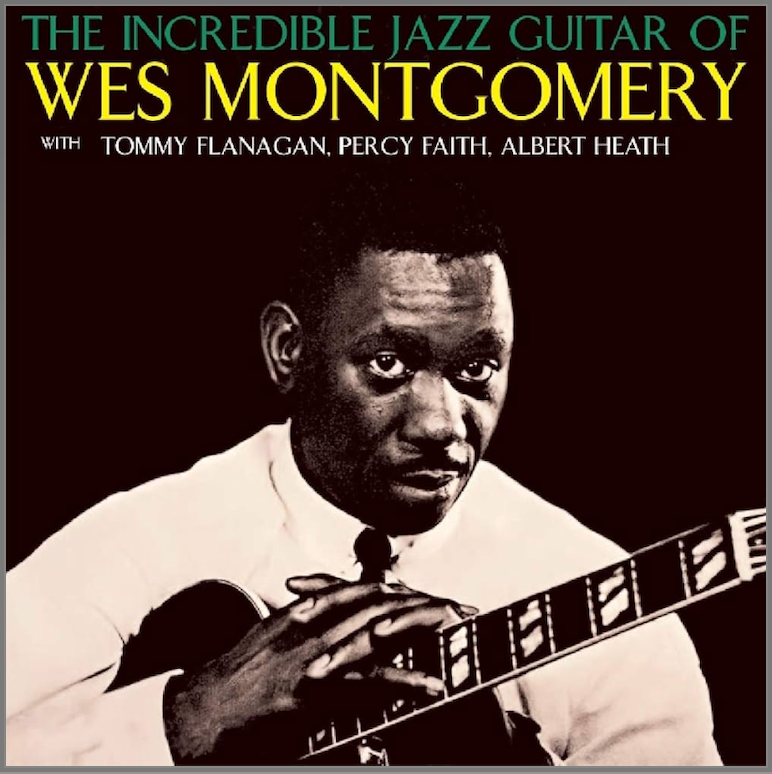
image source: Wikipedia
- Wes Montgomery – Guitar
- Tommy Flanagan – Piano
- Percy Heath – Bass
- Albert Heath – Drums
Released in 1960 by Riverside Records, this album marked Montgomery’s breakthrough in jazz and solidified his reputation as one of the greatest jazz guitarists. This album’s importance to jazz guitar cannot be understated!
The album features several of Montgomery’s signature guitar playing techniques, including “thumb picking” and octaves, which have become essential elements in modern jazz guitar playing.
This classic jazz album blends hard bop with that West Coast sound.
- Airegin
- D-Natural Blues
- Polka Dots and Moonbeams
- Four on Six
- West Coast Blues
- In Your Own Sweet Way
- Mr. Walker
- Gone With the Wind
Reception and Impact
The Incredible Jazz Guitar received critical acclaim upon release, earning a five-star review from Ira Gitler of DownBeat magazine and being regarded as a landmark jazz guitar recording. There is a significant distinction between jazz guitar before and after Wes Montgomery.
This album may be the dividing line.
The Library of Congress selected the album for preservation in the National Recording Registry in 1917 because of its status as “culturally, historically, or aesthetically significant.”
Why It’s On the List
This album set the standard for jazz guitar recordings and introduced Montgomery’s innovative techniques to a broader audience.
Its influence can still be heard in both jazz and popular music, making it a quintessential listen for understanding the evolution of jazz guitar specifically and the West Coast sound more generally.
To learn more about Wes Montgomery, check out our article on the 50 best jazz guitarists ever.
source: Wikipedia
7. Art Blakey and the Jazz Messengers – Moanin’ (1959)
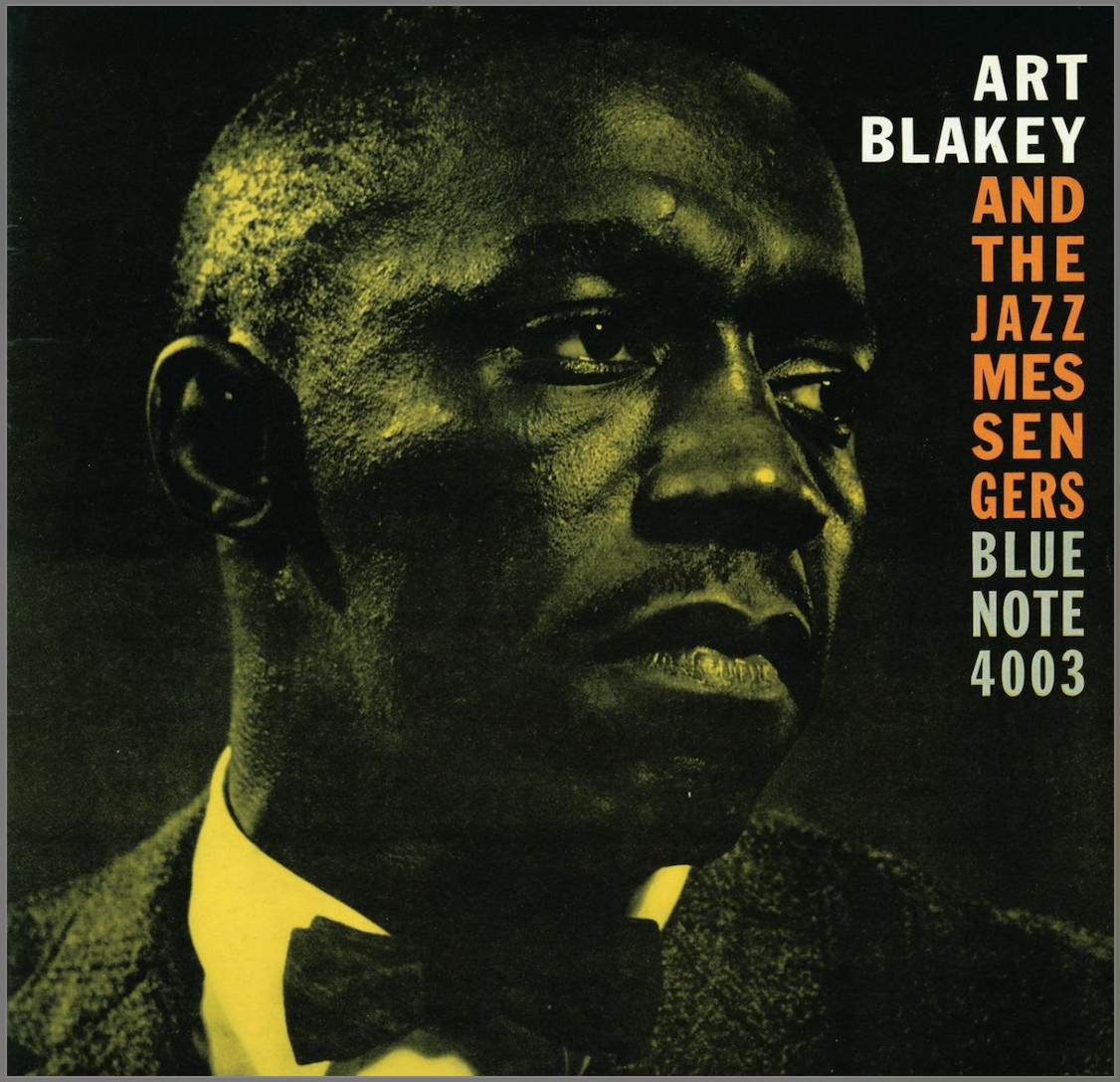
image source: Wikipedia
- Art Blakey – Drums
- Lee Morgan – Trumpet
- Benny Golson – Tenor Saxophone
- Bobby Timmons – Piano
- Jymie Merritt – Bass
Recorded on October 30, 1958, and released in 1959 by Blue Note Records, Moanin’ is one of the most celebrated hard bop albums of its time and set the stage for what jazz would become in the years after its release.
The album is known for its blend of gospel, blues, and jazz, marking a turning point in Art Blakey’s career as a bandleader. It defined the Jazz Messengers’ sound and helped establish Blakey’s reputation as a mentor for young, talented musicians.
Featuring compositions primarily by Benny Golson and Bobby Timmons, the album balances structured arrangements with space for improvisation, making it a quintessential hard bop recording.
- Moanin’
- Are You Real
- Along Came Betty
- The Drum Thunder (Miniature) Suite
- First Theme: Drum Thunder
- Second Theme: Cry a Blue Tear
- Third Theme: Harlem’s Disciples”
- Blues March
- Come Rain or Come Shine
Reception and Impact
Moanin’ was a critical and commercial success upon its release and was recognized as one of the most influential hard-bop albums of all time.
Bobby Timmons’s title track, “Moanin’,” became one of the most famous compositions in the hard bop genre. Its catchy, gospel-inspired melody and call-and-response format have made it a jazz standard.
Benny Golson’s contributions, such as “Along Came Betty” and “Blues March,” also became staples of the Jazz Messengers’ repertoire, with “Along Came Betty” becoming a famous jazz standard in its own right.
Why It’s On This List
Moanin’ solidified Art Blakey and the Jazz Messengers as an iconic jazz ensemble, and it was instrumental in shaping the careers of its members, including Lee Morgan and Benny Golson.
It remains a must-hear for jazz fans looking to explore the hard bop genre.
source: Wikipedia
8. Herbie Hancock – Maiden Voyage (1965)
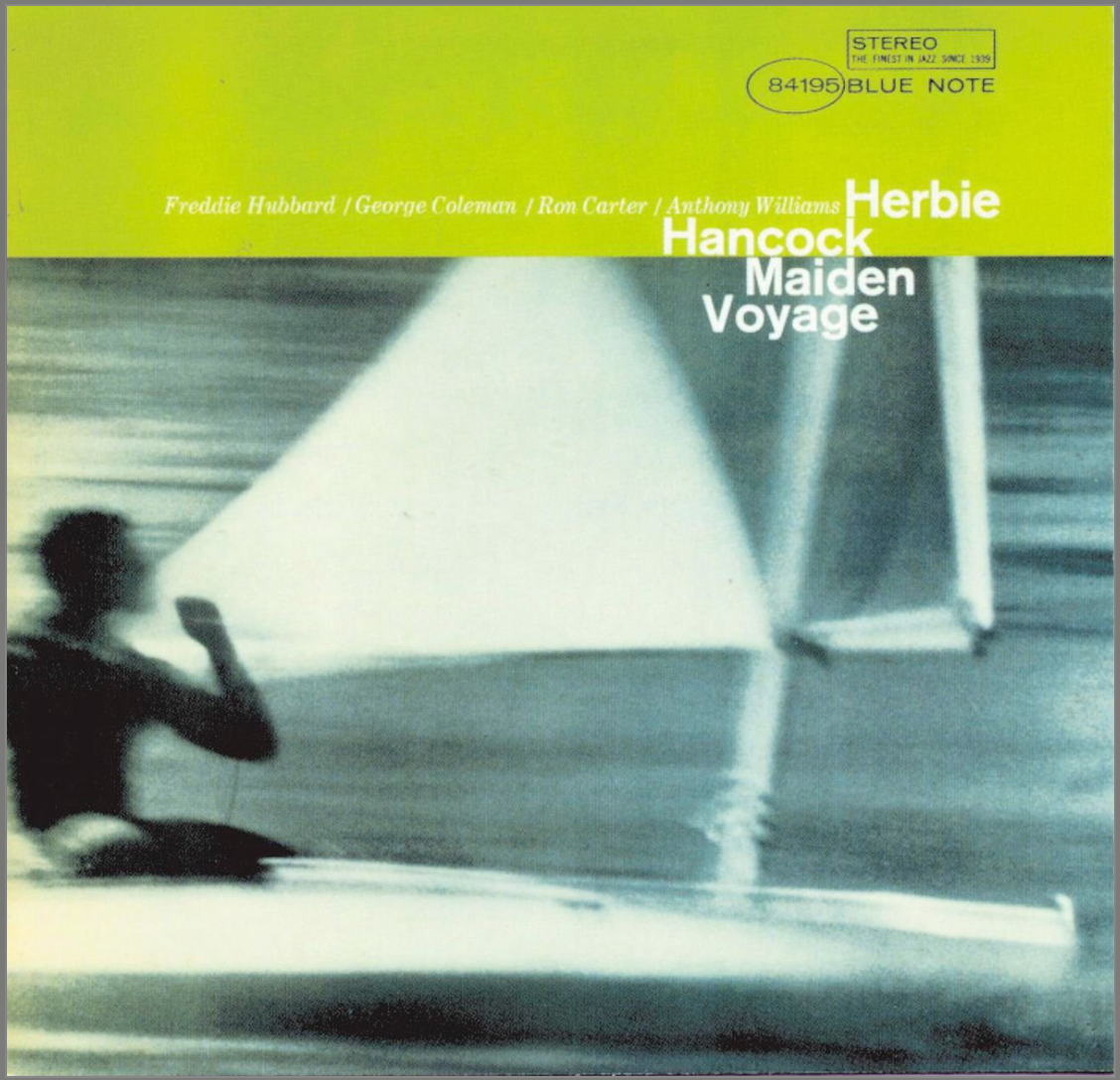
image source: Wikipedia
- Herbie Hancock – Piano
- Freddie Hubbard – Trumpet
- George Coleman – Tenor Saxophone
- Ron Carter – Bass
- Tony Williams – Drums
Recorded on March 17, 1965, Maiden Voyage is Herbie Hancock’s fifth studio album and was released by Blue Note when Herbie Hancock was only 24 years old!
The album is often considered one of the most essential recordings of the post-bop era. It showcases Hancock’s innovative blend of modal jazz and impressionistic composition.
This “concept album” revolves around the theme of the sea. Tracks such as “Maiden Voyage” and “Dolphin Dance” became classic jazz standards.
- Maiden Voyage
- The Eye of the Hurricane
- Little One
- Survival of the Fittest
- Dolphin Dance
Reception and Impact
Maiden Voyage is heralded as a masterpiece and is often mentioned as one of the defining albums of Hancock’s early career.
Over the years, Maiden Voyage has become a touchstone in jazz, influencing countless musicians and spawning numerous covers of its compositions by artists like Ahmad Jamal, Grover Washington Jr., and Bill Evans.
Why It’s On The List
The album’s influence extended beyond jazz, inspiring classical, rock, and contemporary musicians. It is deceptively complex yet quite accessible to the average listener. Maiden Voyage is a perfect example of jazz in the mid-60s and hints at where jazz was heading in the 1970s.
source: Wikipedia
9. Dizzy Gillespie, Sonny Stitt, and Sonny Rollins – Sonny Side Up (1959)

image source: Wikipedia
- Dizzy Gillespie – Trumpet
- Sonny Rollins – Tenor Sax
- Sonny Stitt – Tenor Sax
- Ray Bryant – Piano
- Tommy Bryant – Bass
- Charlie Persip – Drums
Here’s another favorite of mine!
Sonny Side Up was recorded in December 1957 and released in 1959 on Verve Records. It is considered one of the most exhilarating bebop jam session albums, capturing three jazz giants at the height of their improvisational prowess.
Norman Granz produced the album, creating an ideal setting for Rollins and Stitt’s saxophone “battle.” Sonny Rollins’s motific and rhythmically complex saxophone playing contrasts nicely with Sonny Stitt’s technical bebop prowess.
And Dizzy is wholeheartedly Dizzy throughout the entire album. Be sure to check him out singing at the end of “Sunny Side of the Street.” Its energy and attitude feel raw and live like you saw them at a club.
- On the Sunny Side of the Street
- The Eternal Triangle
- After Hours
- I Know That You Know
Reception and Impact
Sonny Side Up’s lively energy and interaction between the performers make this a compelling performance that keeps listeners (at least me) returning.
The album remains a definitive example of the bebop genre and has been highly praised for its spontaneity and virtuosity.
Why It’s On The List
Sonny Side Up is frequently cited as one of the best examples of a jazz jam session, which emphasizes improvisation and real-time interaction between musicians.
The album’s enduring appeal lies in its all-star cast, each bringing a different attitude and energy to this “cutting session.”
source: Wikipedia
10. Ornette Coleman – The Shape of Jazz to Come (1959)
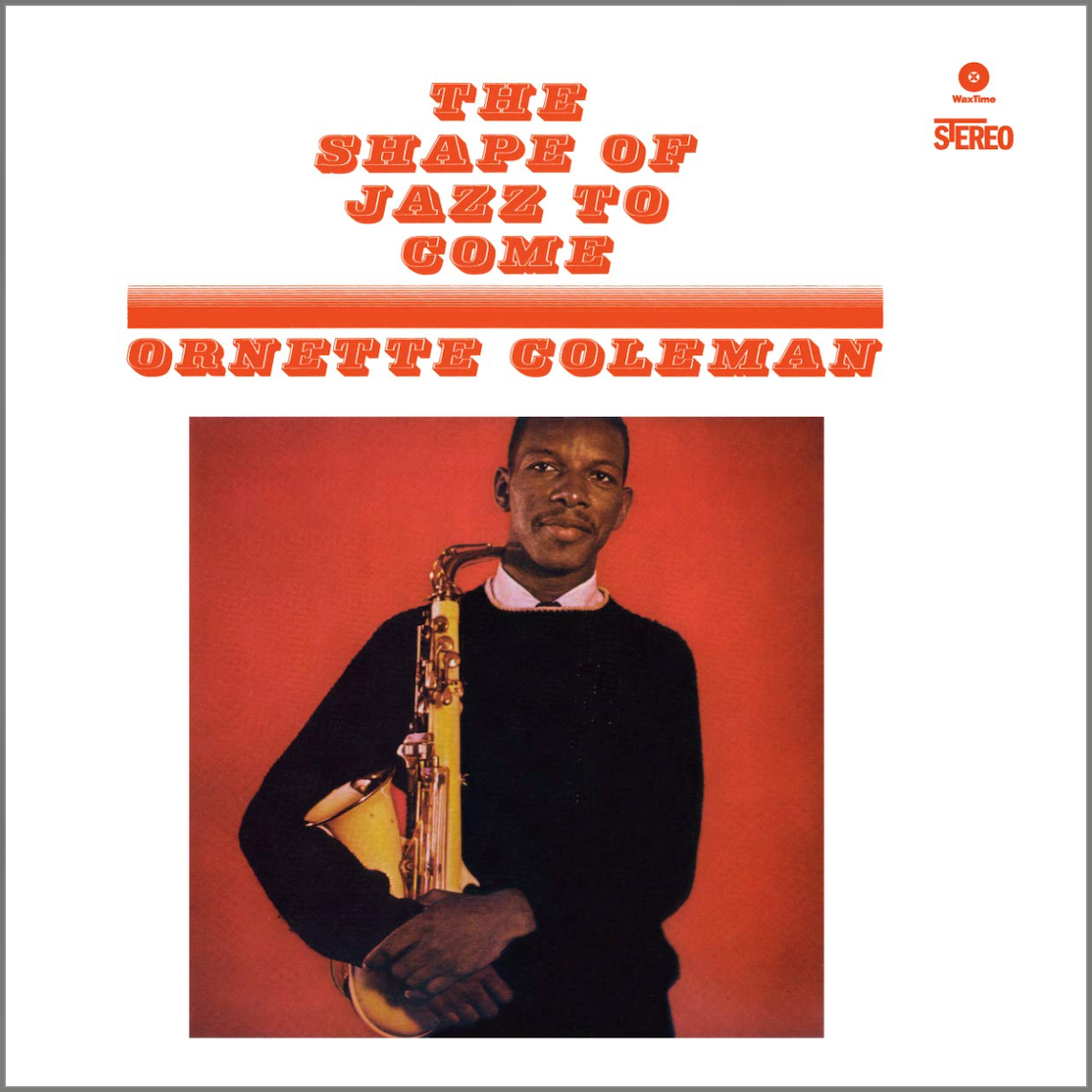
image source: Wikipedia
- Ornette Coleman – Alto Saxophone
- Don Cherry – Cornet
- Charlie Haden – Bass
- Billy Higgins – Drums
Recorded on May 22, 1959, and released later that year in November by Atlantic Records, The Shape of Jazz to Come is widely considered one of the best jazz records ever.
It introduced the world to free jazz, marking a radical departure from traditional jazz by abandoning chordal instruments and fixed harmonic structures. Like Chet Baker and Gerry Mulligan’s group, Ornette Colemans’s quartet didn’t have a chord player, which allowed them to stretch the harmony.
The album’s compositions utilized Coleman’s harmolodic philosophy, which treats harmony, melody, speed, time, and rhythm as equally important. As a result, traditional music’s overemphasis on harmony is deprioritized in Coleman’s music, which moves away from total centers.
- Lonely Woman
- Eventually
- Peace
- Focus on Sanity
- Congeniality
- Chronology
Reception and Impact
The Shape of Jazz to Come generated significant controversy and polarized opinions. Some musicians and critics praised Coleman’s inventiveness, while others were critical of his unconventional approach.
Despite the initial mixed reception, The Shape of Jazz to Come has been recognized as a significant influence on avant-garde jazz and was inducted into the Grammy Hall of Fame in 2015. It is frequently included in various “Best Jazz Albums of All Time” lists.
Why It’s On This List
The Shape of Jazz to Come introduced the world to free jazz. Its emphasis on group improvisation and absence of traditional harmonic constraints made it revolutionary. The album’s influence can be seen in later works by avant-garde musicians and composers across genres.
source: Wikipedia
11. Miles Davis – Bitches Brew (1970)
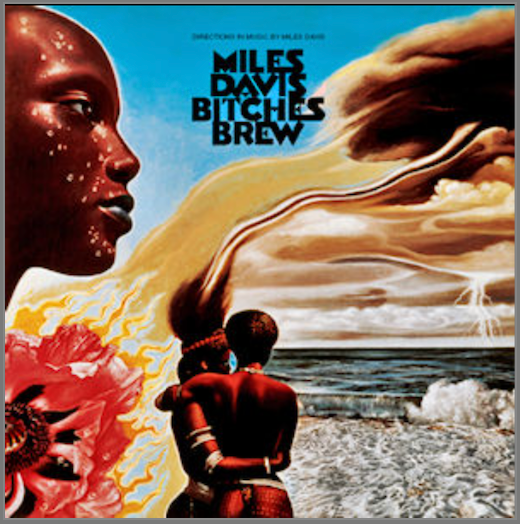
image source: Wikipedia
- Miles Davis – Trumpet
- Wayne Shorter – Soprano Saxophone
- Bennie Maupin – Bass Clarinet
- Joe Zawinul, Chick Corea, and Larry Young – Electric Piano
- John McLaughlin – Electric Guitar
- Dave Holland and Harvey Brooks – Bass
- Jack DeJohnette, Lenny White, and Don Alias – Drums
- Airto Moreira – Percussion
Recorded between August 19-21, 1969, and released in March 1970 by Columbia Records, Bitches Brew is considered a groundbreaking and genre-defining album that launched “jazz-rock.”
The album blends jazz, rock, and funk elements with extensive use of electric instruments, breaking away from traditional jazz norms. Bitches Brew, released after In a Silent Way, continues exploring electric instruments and the fusion of different styles from rock to impressionistic classical music.
Miles Davis gave general directions and ideas regarding the writing and recording process but wanted the musicians he assembled to create the album in a traditionally less structured way.
Also, the audio engineering process broke new ground with Miles and audio engineer Teo Macero utilizing the recording studio in novel ways. The double LP features six extended tracks, with a total runtime of over 90 minutes.
- Pharaoh’s Dance
- Bitches Brew
- Spanish Key
- John McLaughlin
- Miles Runs the Voodoo Down
- Sanctuary
Reception and Impact
Bitches Brew is Miles Davis’s second-best-performing jazz album behind Kind of Blue. From its release, it was both controversial and groundbreaking. Jazz traditionalists saw Bitches Brew as unorthodox and far removed from the idea of what jazz was “supposed to be.”
However, many others recognized the work as a brilliant musical experiment that successfully blended various musical genres and captured a beautiful, spontaneous musical moment in time.
Why It’s On This List
Widely regarded as one of the most influential albums in jazz history, Bitches Brew is considered a turning point not only in Davis’s career but also in the evolution of jazz itself.
Bitches Brew was instrumental in establishing jazz fusion as a genre, inspiring artists such as Weather Report and the Mahavishnu Orchestra. Its emphasis on rhythm and groove paved the way for funk jazz, and its dissonant, almost avant-garde sound influenced progressive rock bands like King Crimson.
source: Wikipedia
12. Keith Jarrett – The Köln Concert (1975)
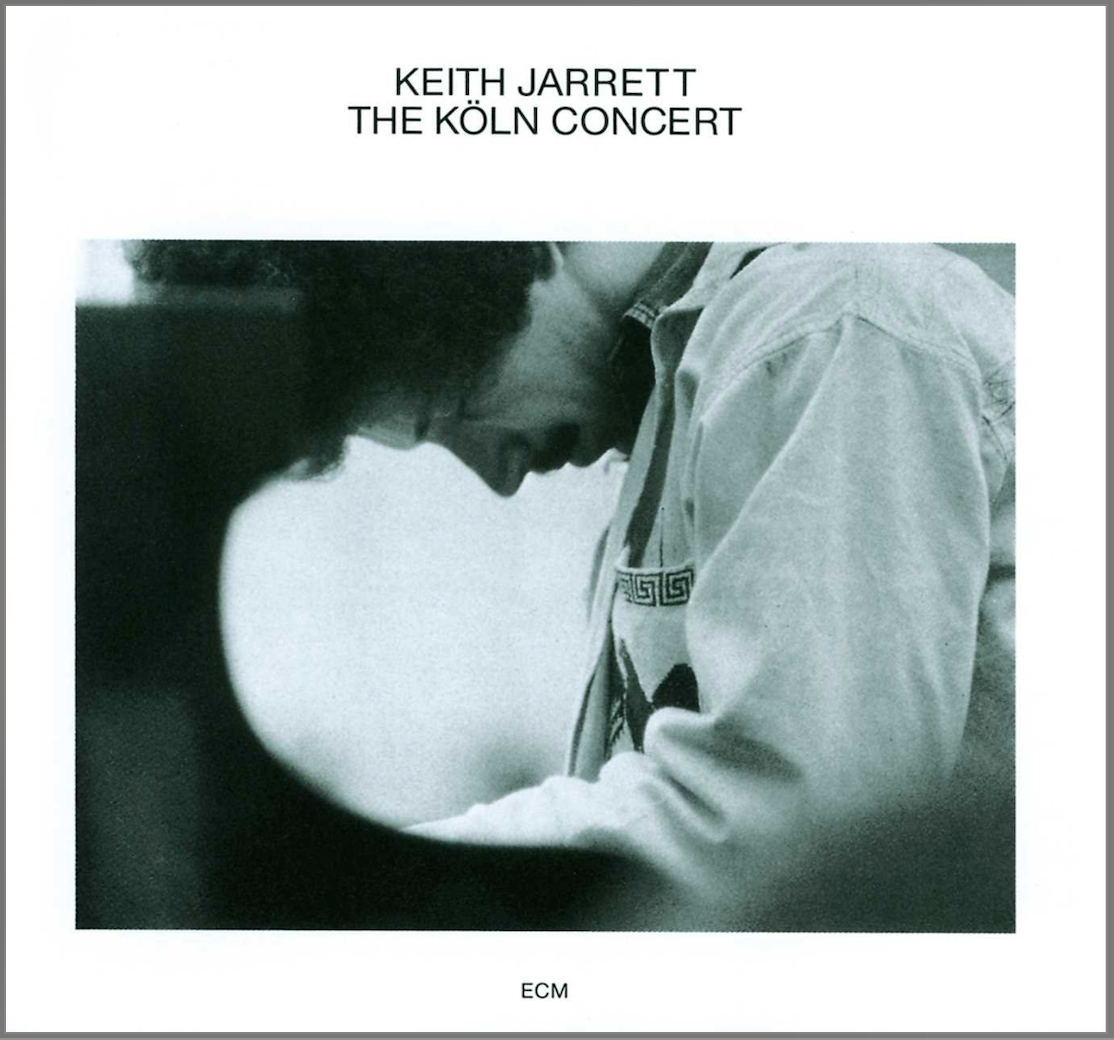
image source: Wikipedia
The Köln Concert was recorded live on January 24, 1975, at the Opera House in Köln, West Germany. This jazz record is one of jazz’s most outstanding solo piano performances. ECM Records released the album later that year.
It has since become the best-selling solo piano and solo jazz album, with over four million copies sold.
Jarrett was exhausted and suffering from chronic back pain, and the piano provided was a substandard baby grand with faulty keys and pedals.
Despite these setbacks, Jarrett pushed through and delivered a legendary performance.
- Part I
- Part II a
- Part II b
- Part II c
Reception and Impact
Upon release, The Köln Concert was met with critical acclaim, noting the impressive breadth of Jarrett’s improvisations, which seamlessly blend jazz, classical, and folk influences.
Critics have highlighted how Jarrett’s technical mastery and expressiveness turned what could have been a compromised performance into an artistic masterpiece.
It has been selected by The Penguin Guide to Jazz Recordings as part of its “core collection” of essential jazz albums and has been listed in Robert Dimery’s book 1001 Albums You Must Hear Before You Die.
This live album cemented Jarrett’s reputation as one of the greatest pianists ever.
Why It’s On This List
The Köln Concert has profoundly impacted jazz, classical, and popular music. It’s a compelling example of a completely improvised solo performance. This concert is also an example of the adage “art from adversity.” It shows that daunting obstacles can lead to creative breakthroughs.
source: Wikipedia
13. Miles Davis – My Funny Valentine: Miles Davis in Concert (1965)
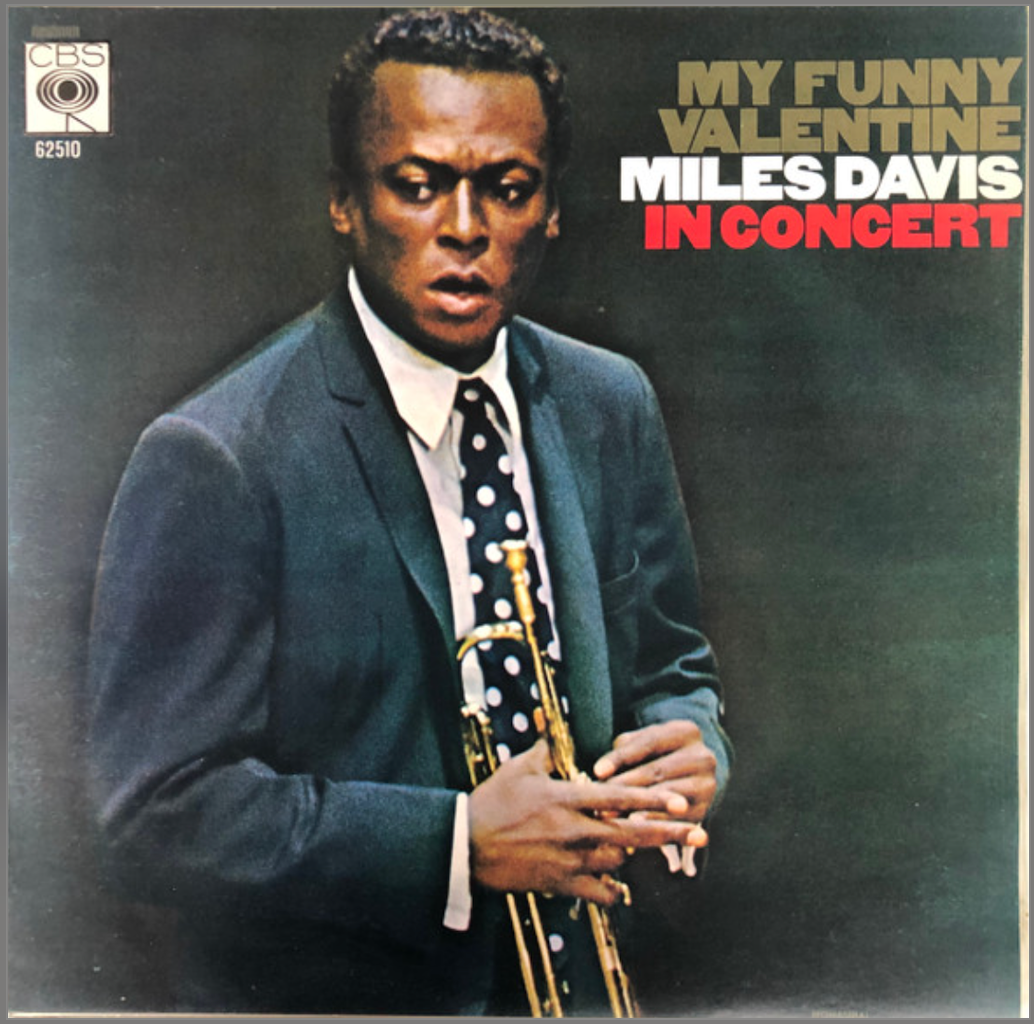
image source: Wikipedia
- Miles Davis – Trumpet
- George Coleman – Tenor Saxophone
- Herbie Hancock – Piano
- Ron Carter – Bass
- Tony Williams – Drums
My Funny Valentine was recorded live on February 12, 1964, at the Philharmonic Hall of Lincoln Center in New York City during a benefit concert for the NAACP, the Congress of Racial Equality, and the Student Nonviolent Coordinating Committee.
Released by Columbia Records in 1965, the album captures the ballad portion of the evening’s performance, focusing on slower, more introspective pieces, contrasting sharply with the companion album Four & More, which contains the uptempo numbers played during the same concert.
This concert marked one of Davis’s final performances of predominantly standard ballads before transitioning into more experimental and avant-garde jazz styles. It also represents one of the last recordings of his second great quintet before saxophonist George Coleman’s departure.
- My Funny Valentine
- All of You
- Stella by Starlight
- All Blues
- I Thought About You
Reception and Impact
The album received critical acclaim and is considered one of Davis’s finest live recordings from the early 1960s. It was praised for its emotional intensity and technical mastery. The quintet’s playing was described as “profoundly felt emotion with the minimum of fuss and the maximum of restraint.”
It has been recognized as a high point for the group, capturing their collective peak as they easily navigated complex time signatures and melodic structures. Each quintet member was given space to shine, with particular praise for Hancock’s expressive piano work and Williams’s dynamic drumming.
Why It’s On The List
My Funny Valentine is often cited as a definitive example of Davis’s mastery in a live setting, balancing technical brilliance with emotional nuance. Its historical significance is further underscored by the context of the benefit concert, which came just months after President Kennedy’s assassination, adding a layer of poignancy to the performance.
The album remains a critical favorite and is featured in many “best live jazz recordings” lists, serving as a critical document of Miles Davis’s transitional period before his foray into the modal and electric eras that defined his later career.
source: Wikipedia
14. Herbie Hancock – Head Hunters (1973)
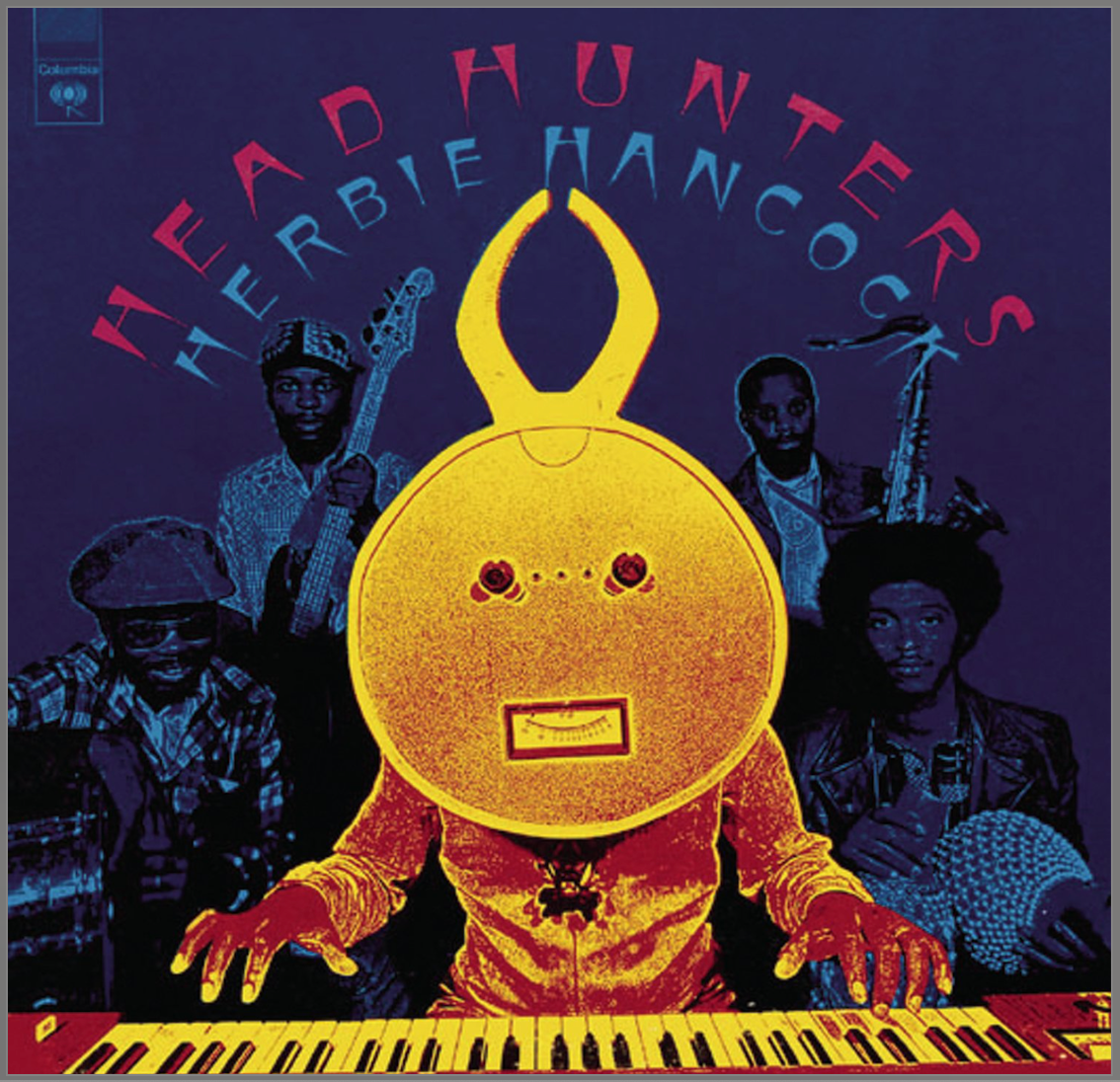
image source: herbiehancock.com
- Herbie Hancock – Fender Rhodes Electric Piano, Hohner D6 Clavinet, ARP Odyssey & ARP Pro Soloist Synthesizers
- Bennie Maupin – Tenor Saxophone, Soprano Saxophone, Saxello, Bass Clarinet, Alto Flute
- Paul Jackson – Bass Guitar, Marímbula
- Harvey Mason – Drums, Arrangements
- Bill Summers – Percussion (including agogô, balafon, congas, and beer bottle on “Watermelon Man”)
Head Hunters, released in October 1973 by Columbia Records, is one of history’s most iconic jazz fusion albums and is often cited as a genre landmark. Hancock sought to create a fusion of jazz, funk, and rock, inspired by artists like Sly Stone and James Brown while maintaining a strong jazz core.
The album was a commercial success, peaking at No. 13 on the Billboard 200 and becoming the first jazz album to achieve Platinum status, eventually selling over a million copies. It marked a major shift in Hancock’s career from his earlier acoustic jazz work to a more electric and groove-focused sound.
Reception and Impact
Head Hunters was widely praised for its innovation and is still considered a quintessential jazz-funk recording. In 2007, the album was added to the Library of Congress’s National Recording Registry for its cultural, historical, and aesthetic significance.
The record has had a profound influence on jazz and genres like funk, hip-hop, and electronic music. Its tracks, especially “Chameleon” and “Watermelon Man,” have been heavily sampled by hip-hop artists such as 2Pac and Digable Planets, cementing its foundational work in jazz and popular music.
Why It’s On This List
Head Hunters is considered a pivotal album that expanded the possibilities of jazz, merging traditional jazz elements with contemporary funk and electronic sounds. It remains influential today and is studied for its groundbreaking production techniques and genre-blending style.
The album’s impact is reflected in its continued presence in “best jazz albums of all time” lists, and it has been a touchstone for generations of musicians across multiple genres.
source: Wikipedia
15. Chick Corea and Return to Forever – Light As A Feather (1972)

image source: Wikipedia
- Chick Corea – Electric Piano (Fender Rhodes)
- Joe Farrell – Flute, Soprano Saxophone
- Stanley Clarke – Double Bass
- Airto Moreira – Drums, Percussion
- Flora Purim – Vocals, Percussion
It’s time for another personal favorite!
This incredible jazz record was recorded on October 8 and 15, 1972, and released the following year by ECM Records. Light as a Feather marks the second album of Chick Corea’s iconic fusion project Return To Forever.
Return To Forever helped launch the founding member and bass phenom Stanley Clarke’s career.
The album blends elements of jazz, Latin music, and Brazilian rhythms, making it a cornerstone in the early jazz fusion movement.
- You’re Everything
- Light as a Feather
- Captain Marvel
- 500 Miles High
- Children’s Song
- Spain
Reception and Impact
This album and its predecessor, Return to Forever (1972), were highly influential in the evolution of jazz into the electronic age. There were many routes jazz took after Miles Davis’s Bitches Brew (1970), and Chick Corea’s vision of Brazillian-inspired fusion is one of the most enduring.
This album is often included in “Best Jazz Albums Of All Time” lists and made Tom Moon’s 1,000 Albums to Hear Before You Die. The Return to Forever period marked a turning point in Corea’s career, setting the stage for his later work with the group and influencing the direction of jazz fusion.
Why It’s On This List:
Light As a Feather is often listed among the best fusion albums of the era and helped inspire other artists who were fusing jazz with other genres.
source: Wikipedia
BEFORE YOU CONTINUE...
If you struggle to learn jazz standards by ear, memorize them, and not get lost in the song form, then our free guide will completely change the way you learn tunes forever.
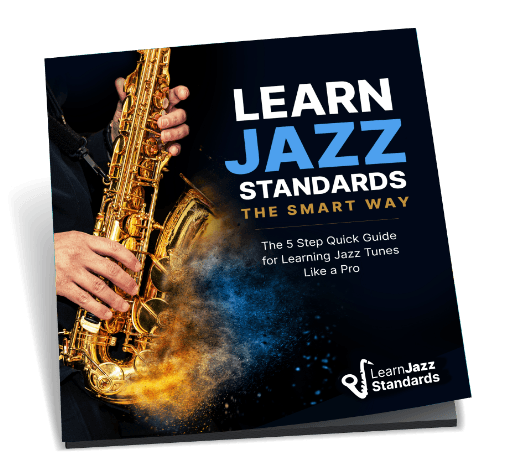
16. Charles Mingus – Mingus Ah Um (1959)
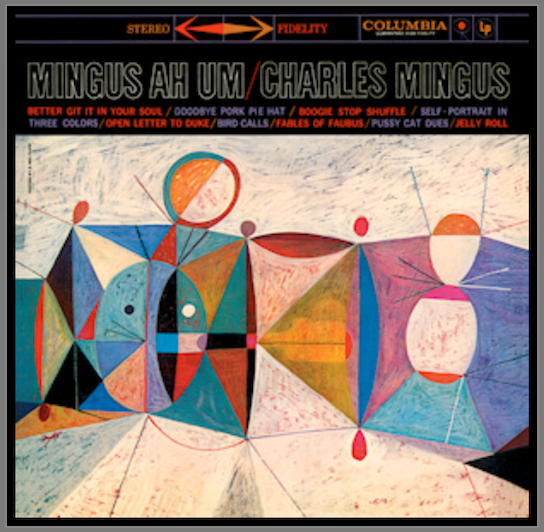
image source: Wikipedia
- Charles Mingus – Bass, Piano (track 10)
- John Handy – Alto Saxophone, Clarinet, Tenor Saxophone
- Booker Ervin – Tenor Saxophone
- Shafi Hadi – Alto and Tenor Saxophones
- Willie Dennis – Trombone
- Jimmy Knepper – Trombone
- Horace Parlan – Piano
- Dannie Richmond – Drums
Columbia Records released Mingus Ah Um in 1959. It was Mingus’s first album for Columbia. In many ways, it’s a jazz concept album because it features compositions dedicated to various jazz legends who inspired Mingus.
Tributes to several jazz legends include “Goodbye Pork Pie Hat,” written for Lester Young, and “Open Letter to Duke,” honoring Duke Ellington. “Jelly Roll” and “Bird Calls” each pay tribute to Jelly Roll Morton and Charlie Parker.
- Better Git It in Your Soul
- Goodbye Pork Pie Hat
- Boogie Stop Shuffle
- Self-Portrait in Three Colors
- Open Letter to Duke
- Bird Calls
- Fables of Faubus
- Pussy Cat Dues
- Jelly Roll
Reception and Impact
Mingus Ah Um won many accolades upon its release and is now considered one of the best jazz albums of all time. It was inducted into the Grammy Hall of Fame and selected for preservation in the National Recording Registry by the Library of Congress in 2003.
Also, the album was inducted into the Grammy Hall of Fame in 2013.
Why It’s On This List
The album is considered a template for the “jazz concept album,” emphasizing thematic unity and coherent sequencing rather than being a series of standards.
Mingus’s ability to blend his vision with jazz traditions made Mingus Ah Um a clear statement of the artist’s identity.
source: Wikipedia
17. Sonny Rollins – Saxophone Colossus (1956)
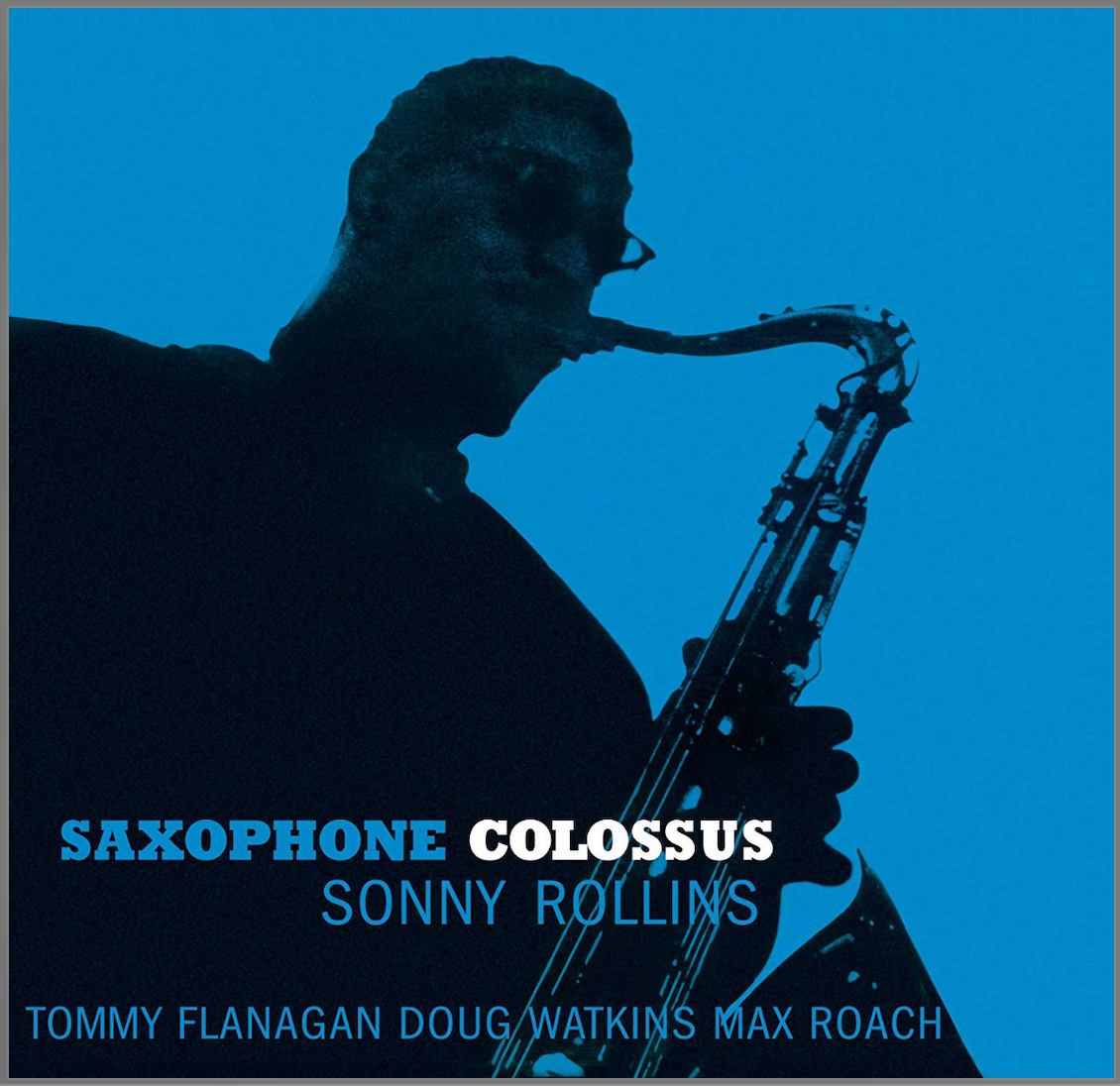
image source: Wikipedia
- Sonny Rollins – Tenor Saxophone
- Tommy Flanagan – Piano
- Doug Watkins – Bass
- Max Roach – Drums
Saxophone Colossus was recorded on June 22, 1956, at Van Gelder Studio in Hackensack, New Jersey, and released the following year by Prestige Records. Not only is Saxophone Colossus considered a hard bop masterpiece, but it is also the jazz record for which Sonny Rollins is best known.
It features one of my favorite tunes as the opening track—”St. Thomas.”
- St. Thomas
- You Don’t Know What Love Is
- Strode Rode
- Moritat
- Blue 7
Reception and Impact
Upon release, Saxophone Colossus received critical acclaim and has since been hailed as one of the greatest examples of hard bop in the jazz world. This album also showcases Rollins’s mastery of thematic development and motivic improvisation.
The album has been inducted into the Library of Congress’s National Recording Registry, cementing its status as a culturally and historically significant recording.
Why It’s On This List
Saxophone Colossus is Sonny Rollins’s masterpiece and a quintessential hard bop record. The album’s enduring popularity and artistic depth continue to inspire musicians and listeners alike, making it essential listening for any jazz fan.
Jazz students should also intensely study the Sonny Rollins solo on “St. Thomas” because it is a masterclass in motivic and rhythmic development.
source: Wikipedia
18. Joe Henderson – Page One (1963)
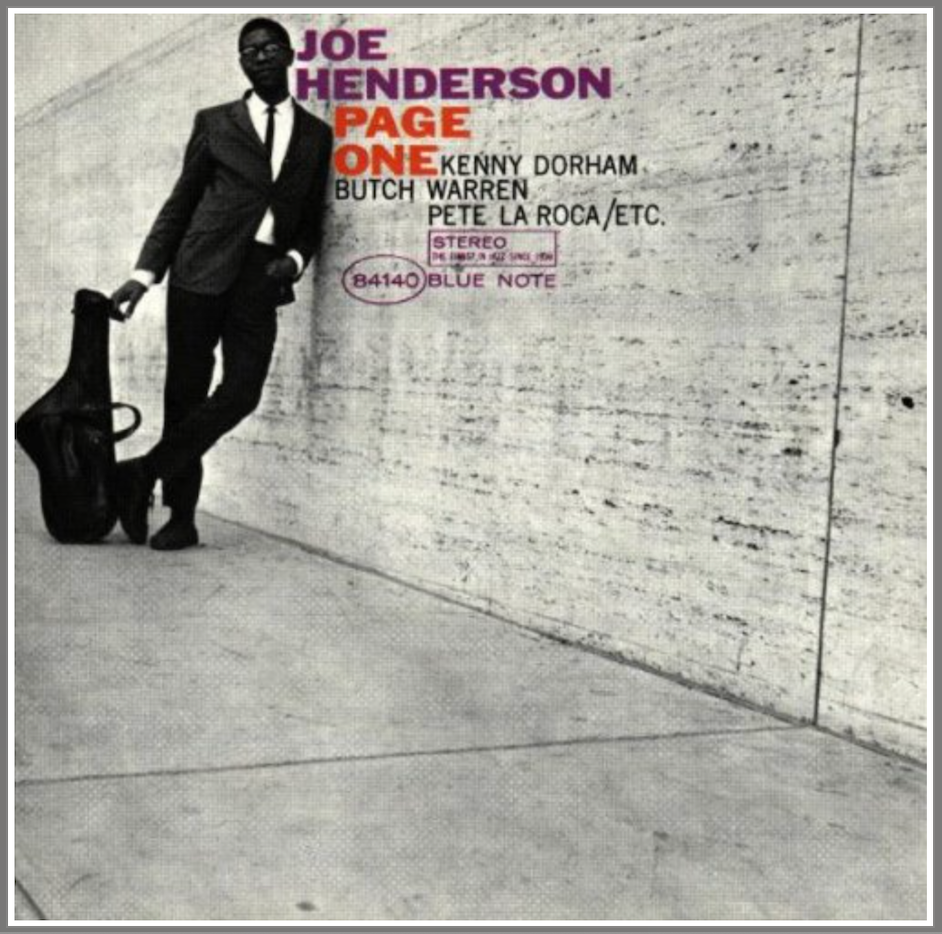
image source: Wikipedia
- Joe Henderson – Tenor Saxophone
- Kenny Dorham – Trumpet
- McCoy Tyner – Piano
- Butch Warren – Bass
- Pete La Roca – Drums
Page One is Joe Henderson’s debut album, recorded and released by Blue Note Records in 1963. The album is noted for its sophisticated compositions and a stellar lineup of musicians, including trumpeter Kenny Dorham and pianist McCoy Tyner, who were already giants of jazz expression.
The album includes six tracks, with two compositions that have become jazz standards: Henderson’s “Recorda Me” and Dorham’s “Blue Bossa.” Both tracks showcase a blend of Latin rhythms and jazz, which helped the album stand out in the hard bop genre.
Notably, Page One was recorded at Rudy Van Gelder’s studio, a location synonymous with high-quality jazz recordings, and produced by Alfred Lion, a co-founder of Blue Note Records.
- Blue Bossa
- La Mesha
- Homestretch
- Recorda Me
- Jinrikisha
- Out of the Night
Reception and Impact
Page One was well-received upon its release and is considered one of Henderson’s finest early works. The album established Henderson as a significant new voice in jazz and has been frequently cited as an essential hard bop recording. It has remained in print since its release, a testament to its enduring appeal and critical acclaim.
The album is often praised for its lyrical yet innovative improvisational style. Tracks like “Blue Bossa” and “Recorda Me” are celebrated for their catchy melodies and rhythmic sophistication, making them staples in the jazz repertoire.
Why It’s On The List
Page One is considered a milestone in Henderson’s career and a landmark in the development of hard bop. Its blend of styles and impeccable musicianship have influenced generations of jazz musicians and are still referenced today in jazz education and performance settings
source: Wikipedia
19. Bill Evans Trio – Waltz for Debby (1962)
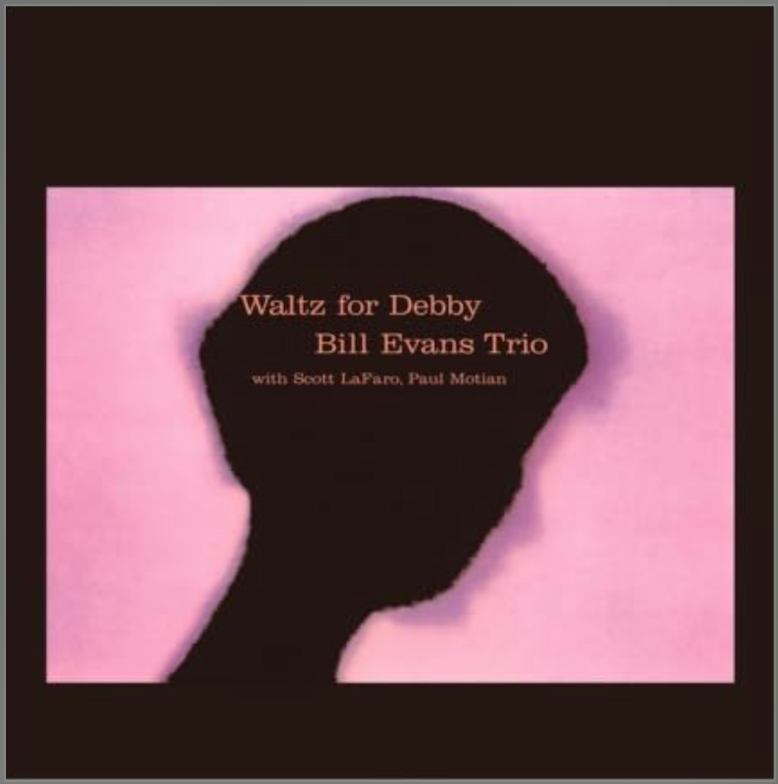
image source: Wikipedia
- Bill Evans – Piano
- Scott LaFaro – Bass
- Paul Motian – Drums
Recorded live at the Village Vanguard in New York City on June 25, 1961, Waltz for Debby is a landmark album in jazz history and one of the final recordings by the original trio before Scott LaFaro’s untimely death.
Released in 1962 by Riverside Records, the album serves as a companion to Sunday at the Village Vanguard. Both albums capture the trio’s highly interactive style, which redefined the role of each instrument within the traditional jazz trio setting.
- My Foolish Heart
- Waltz for Debby
- Detour Ahead
- My Romance
- Some Other Time
- Milestones
Reception and Impact
Waltz for Debby was celebrated for its nuanced interaction between members, solidifying the Bill Evans Trio’s reputation as one of jazz’s most influential trios in the piano trio format.
The recording is also notable for its intimate live atmosphere. The audience’s presence is captured in the background, enhancing the authenticity of the performance.
Why It’s On This List
Waltz for Debby remains a beloved classic in the jazz repertoire. This live recording is considered one of Evans’s finest, displaying his introspective style and masterful technique. The title track, “Waltz for Debby,” is a composition by Evans dedicated to his niece and is now a bonafide jazz standard.
The album’s exploration of complex harmonies and subtle group interplay has had a lasting impact on the jazz genre, influencing not only pianists but also bassists and drummers in their approach to trio playing.
source: Wikipedia
20. Horace Silver – Song for My Father (1965)
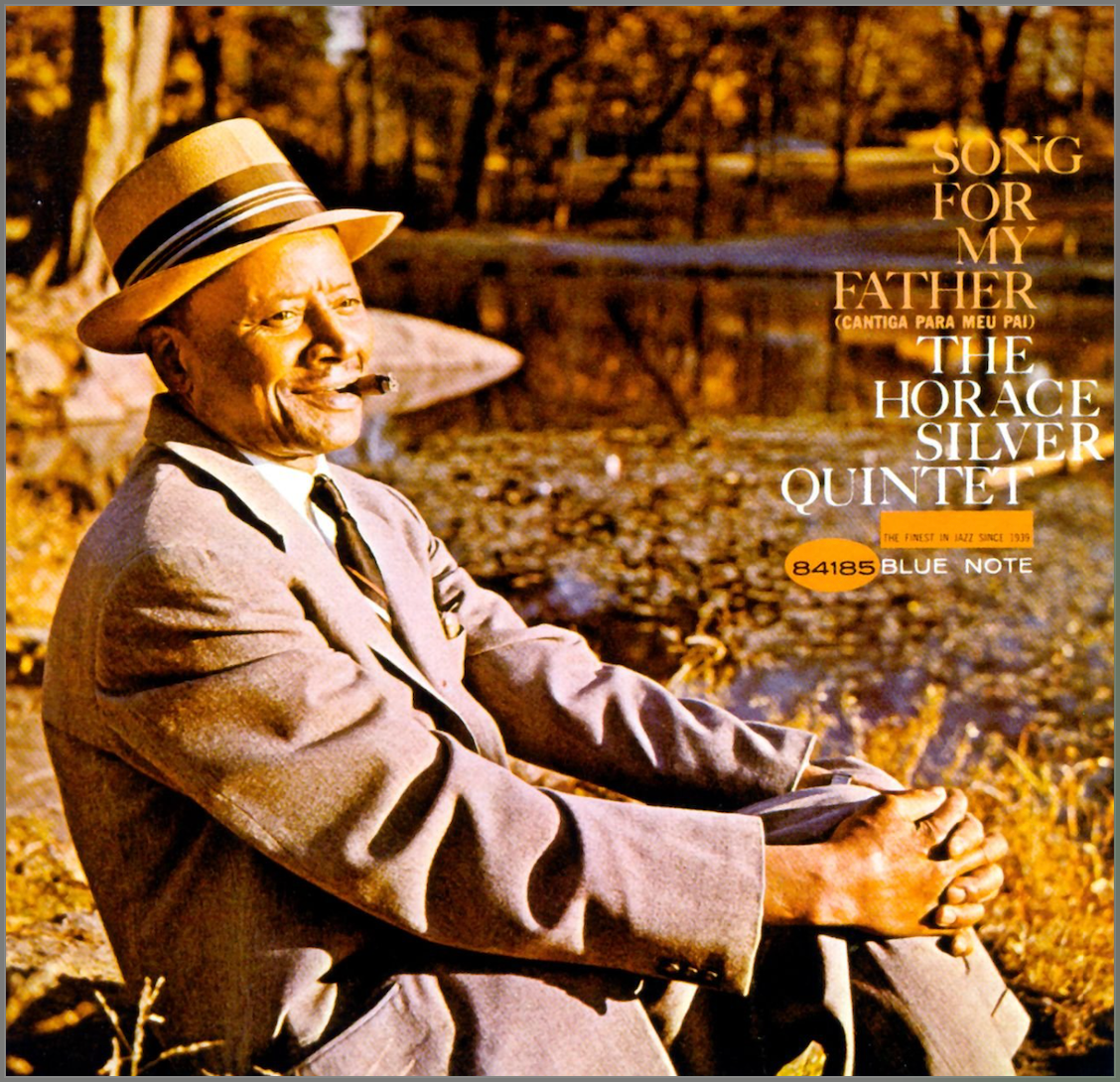
image source: Wikipedia
- Horace Silver – Piano
- Carmell Jones – Trumpet
- Joe Henderson – Tenor Saxophone
- Teddy Smith – Bass
- Roger Humphries – Drums
- Blue Mitchell – Trumpet
- Junior Cook – Tenor Saxophone
- Gene Taylor – Bass
- Roy Brooks – Drums
Song for My Father was recorded between 1963 and 1964 and released in January 1965 by Blue Note Records. The album is considered a quintessential hard bop recording, blending Silver’s blues, gospel, and bebop roots with Brazilian-inspired rhythms and harmonies.
The title track, “Song for My Father,” was written as a tribute to Silver’s father, John Tavares Silva, and is known for its bossa nova influence. The album cover features a photograph of Horace Silver’s father.
- Song for My Father
- The Natives Are Restless Tonight
- Calcutta Cutie
- Que Pasa
- The Kicker
- Lonely Woman
Reception and Impact
Song for My Father was a critical and commercial success and became one of Silver’s most well-known albums. The album was accessible yet sophisticated and cemented Silver’s status as a leading figure in the hard bop genre.
The title track has been highly influential beyond jazz, notably inspiring Steely Dan’s “Rikki Don’t Lose That Number” and other pop songs. Its instantly recognizable bass line and melody have been covered by artists across genres, from hip-hop producer Madlib to guitarist George Benson.
Why It’s On The List
The album is Silver’s masterpiece and a quintessential representation of the hard bop genre. Its success, along with Lee Morgan’s The Sidewinder, helped propel Blue Note Records to new commercial heights.
Also, “Song for My Father” remains a beloved standard.
source: Wikipedia
21. Robert Glasper Experiment – Black Radio (2012)
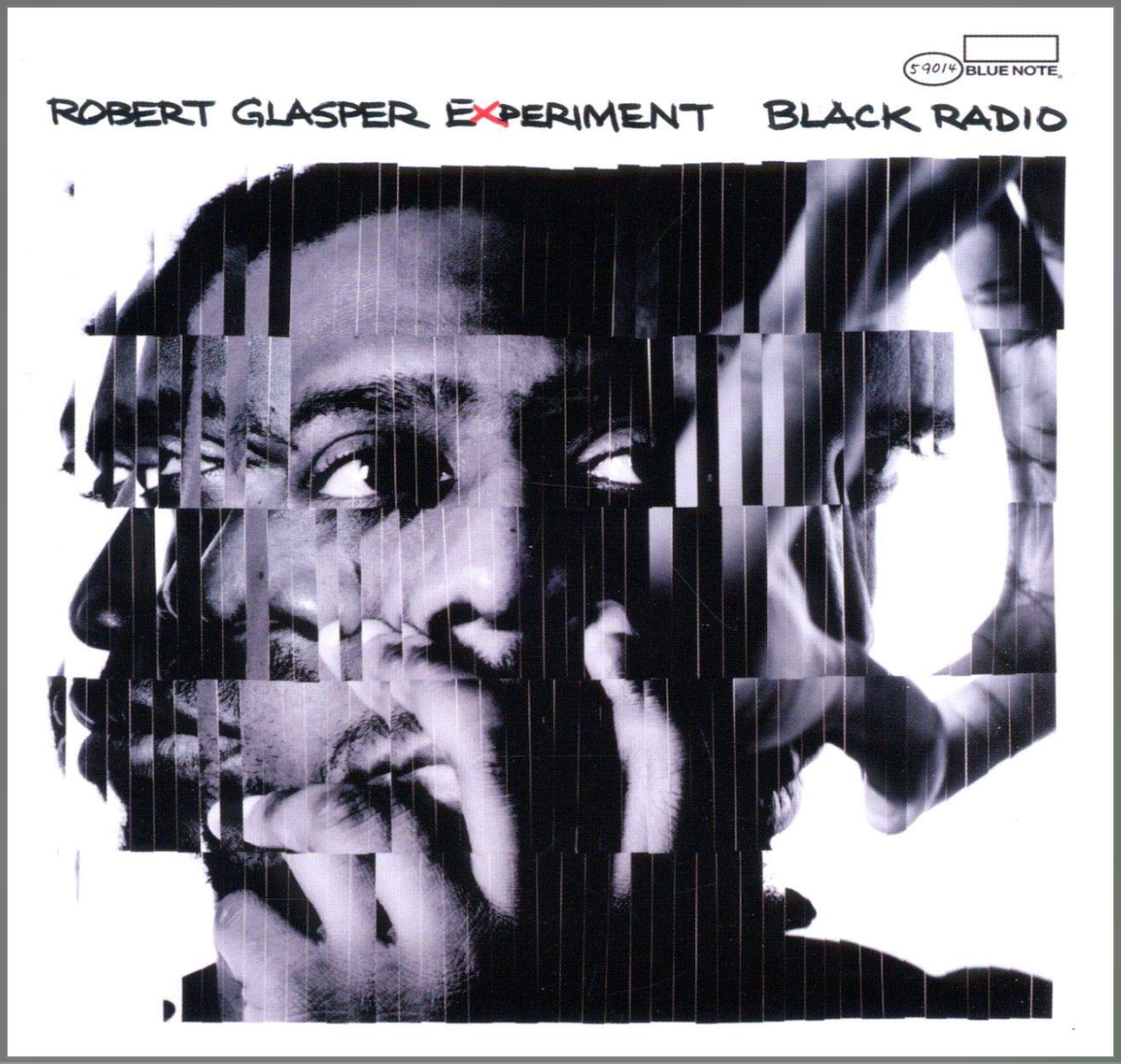
image source: Wikipedia
- Robert Glasper – Keyboards, Piano, Fender Rhodes
- Derrick Hodge – Bass
- Chris Dave – Drums
- Casey Benjamin – Vocoder, Flute, Saxophone
- Jahi Sundance – Turntables (selected tracks)
- Plus, many more featured artists!
Released on February 28, 2012, by Blue Note Records, Black Radio marked a significant shift in Robert Glasper’s career, merging his jazz background with hip-hop, neo-soul, and R&B.
Black Radio has collaborations with prominent artists from many genres, showcasing Glasper’s versatility and boundary-pushing vision. This approach allowed the Robert Glasper Experiment to blend live instrumentation with digital production, creating a cohesive yet eclectic sound.
- Lift Off / Mic Check
- Afro Blue
- Cherish the Day
- Always Shine
- Gonna Be Alright (F.T.B.)
- Move Love
- Ah Yeah… That’s Just Great
- The Consequences of Jealousy
- Why Do We Try
- Black Radio
- Letter to Hermione
- Smells Like Teen Spirit
Reception and Impact
Black Radio received critical acclaim for its innovative blend of genres and was praised for bridging the gap between jazz and contemporary Black music styles. It debuted at No. 15 on the Billboard 200 and reached No. 1 on the Jazz Albums chart.
The album won the Grammy Award for Best R&B Album in 2013, marking a significant achievement for a jazz-influenced record.
Why It’s On The List
Black Radio is considered a pivotal album for the evolution of contemporary jazz. Its success helped establish Glasper as a prominent figure in contemporary Black music and expanded the definition of a jazz album in the 21st century.
source: Wikipedia
22. Dexter Gordon – Go (1962)
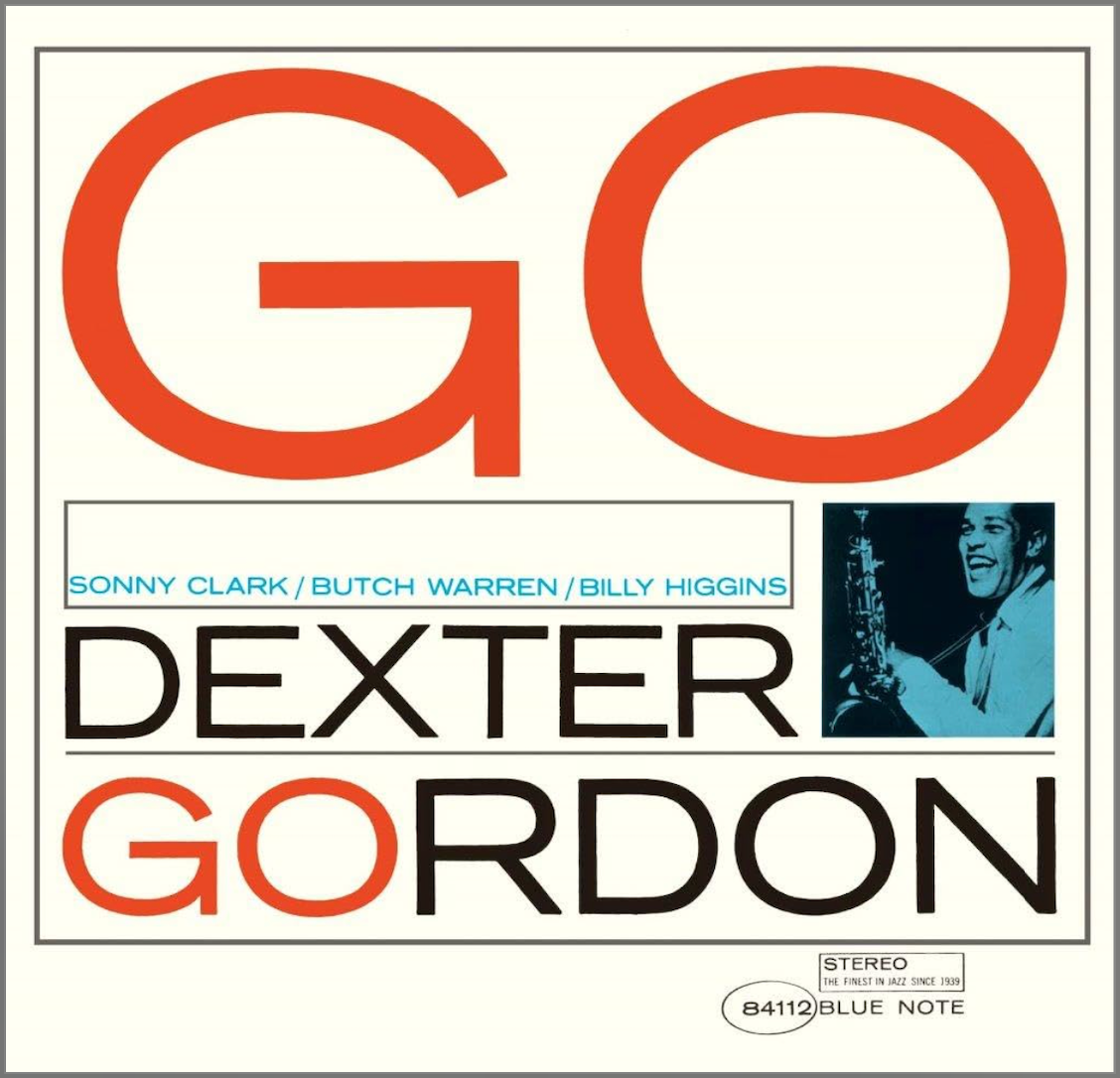
image source: Wikipedia
- Dexter Gordon – Tenor Saxophone
- Sonny Clark – Piano
- Butch Warren – Bass
- Billy Higgins – Drums
Go was recorded on August 27, 1962, at Rudy Van Gelder Studio in New Jersey and released by Blue Note Records. Go is regarded as one of Gordon’s most accomplished albums, showcasing his mastery of hard bop.
The recording session was recorded with a younger rhythm section featuring pianist Sonny Clark, bassist Butch Warren, and drummer Billy Higgins. Notoriously, the session had all the vibes of a live club performance, but it was captured in the studio.
- Cheese Cake
- I Guess I’ll Hang My Tears Out to Dry
- Second Balcony Jump
- Love for Sale
- Where Are You?
- Three O’Clock in the Morning
Reception and Impact
The Library of Congress inducted Go into the National Recording Registry, recognizing its historical and cultural significance. The album was a commercial success and helped revitalize Gordon’s career. It led to a series of well-regarded recordings with Blue Note through the 1960s.
Why It’s On The List
Go is a definitive example of Gordon’s late-career resurgence and a high point in his discography. It remains a recommended entry point for listeners new to his music and is often cited in “best jazz albums of all time” lists.
source: Wikipedia
23. Hank Mobley – Soul Station (1960)
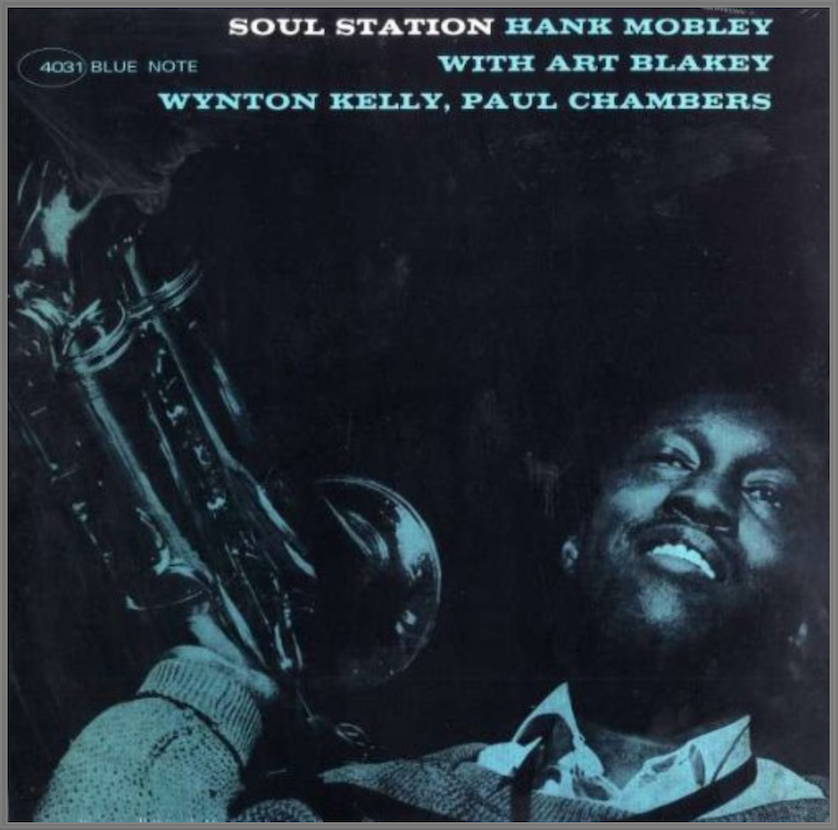
image source: Wikipedia
- Hank Mobley – Tenor Saxophone
- Wynton Kelly – Piano
- Paul Chambers – Bass
- Art Blakey – Drums
Soul Station was recorded on February 7, 1960, at Van Gelder Studio in Englewood Cliffs, New Jersey, and released later that year by Blue Note Records.
The album is quintessential hard bop. This recording was significant as it placed Mobley, someone less well-known than contemporaries like John Coltrane or Sonny Rollins, on their level as a band leader and sax player.
The rhythm section featured Wynton Kelly, Paul Chambers, and Art Blakey, all household names in jazz.
- Remember
- This I Dig of You
- Dig Dis
- Split Feelin’s
- Soul Station
- If I Should Lose You
Reception and Impact
Soul Station put Hank Mobley on the map. Critics praised the album for its balance and structure and for showcasing Mobley’s bebop sax chops and masterful solos.
Over the decades, Soul Station has gained even more recognition, earning spots in prestigious jazz album guides like The Rolling Stone Jazz Record Guide and The Penguin Guide to Jazz Recordings. It is now considered one of its era’s most important jazz albums.
Why It’s On The List
Soul Station has stood the test of time as a benchmark for tenor saxophonists and a high point in the hard bop genre.
While Mobley may not have been considered a pioneer like John Coltrane or Sonny Rollins, this album solidified his place as a hard-bop jazz icon.
source: Wikipedia
24. McCoy Tyner – The Real McCoy (1967)
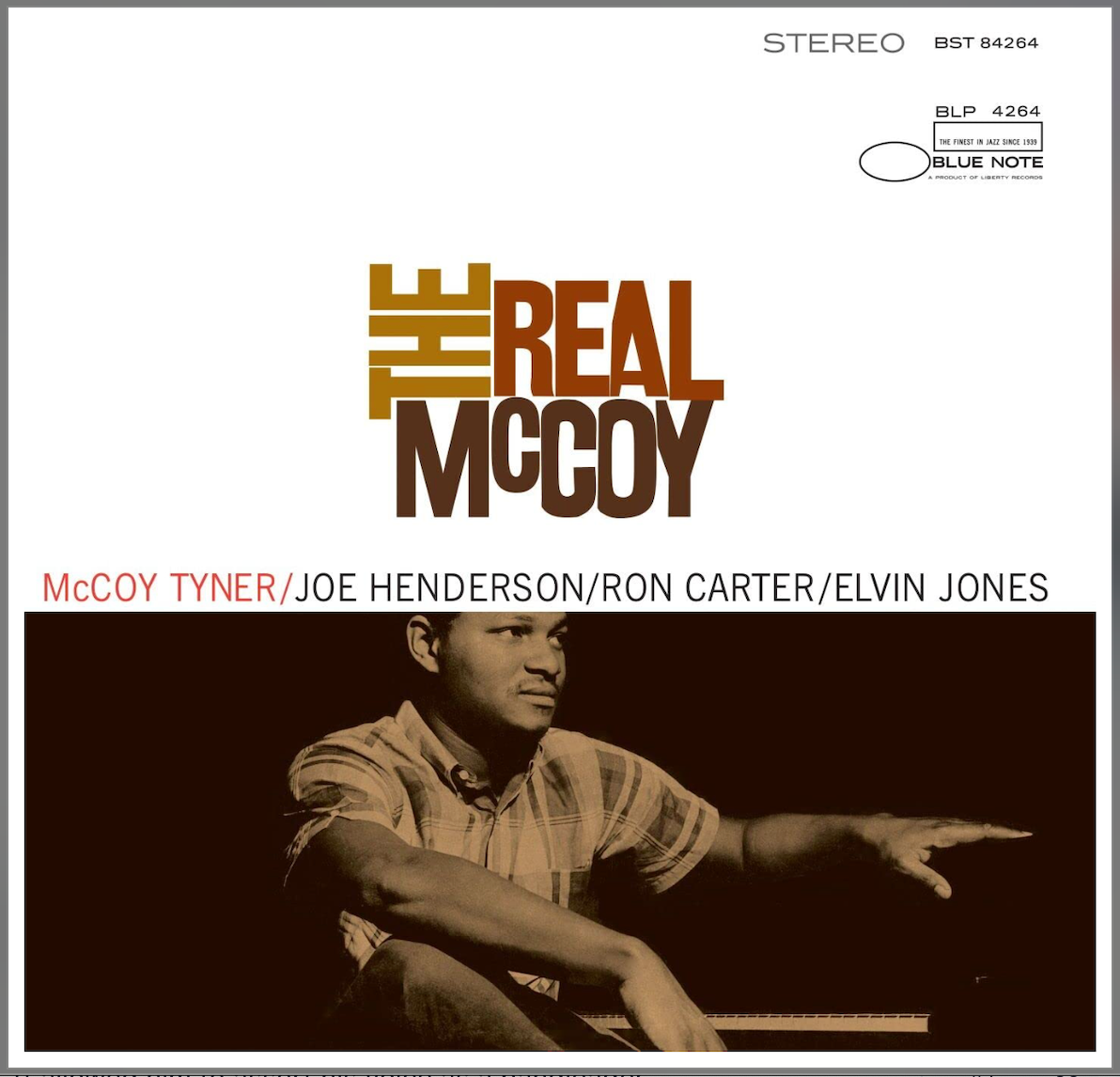
image source: Wikipedia
- McCoy Tyner – Piano
- Joe Henderson – Tenor Saxophone
- Ron Carter – Bass
- Elvin Jones – Drums
The Real McCoy, Tyner’s first album, was recorded on April 21, 1967, at Van Gelder Studio in Englewood Cliffs, New Jersey. It was released on the Blue Note label following his departure from John Coltrane’s quartet.
The album marked a pivotal moment in Tyner’s career. It allowed him to assert his voice as a bandleader and composer and showcased his distinct harmonic style, which would go on to influence other pianists.
The album’s compositions combine hard bop, modal jazz, and McCoy Tyner’s original playing style.
- Passion Dance
- Contemplation
- Four by Five
- Search for Peace
- Blues on the Corner
For more on the chord voicings McCoy Tyner uses, check out our article on quartal harmony.
Reception and Impact
The Real McCoy was featured in The Penguin Guide to Jazz‘s “Core Collection” for its cohesive structure and expressive power, solidifying Tyner’s status as one of the leading post-bop pianists.
The album’s unique harmonic structures, built on open, unresolved chords, combined with Henderson’s distinctive saxophone lines, created a dynamic interplay that made it one of the standout releases of the late 1960s
Why It’s On This List
The Real McCoy remains a highly influential recording in the post-bop genre. It is frequently cited as the ideal entry point for exploring Tyner’s extensive body of work and is considered one of the classic jazz albums of the 1960s.
source: Wikipedia
25. Stan Getz and João Gilberto – Getz/Gilberto (1964)
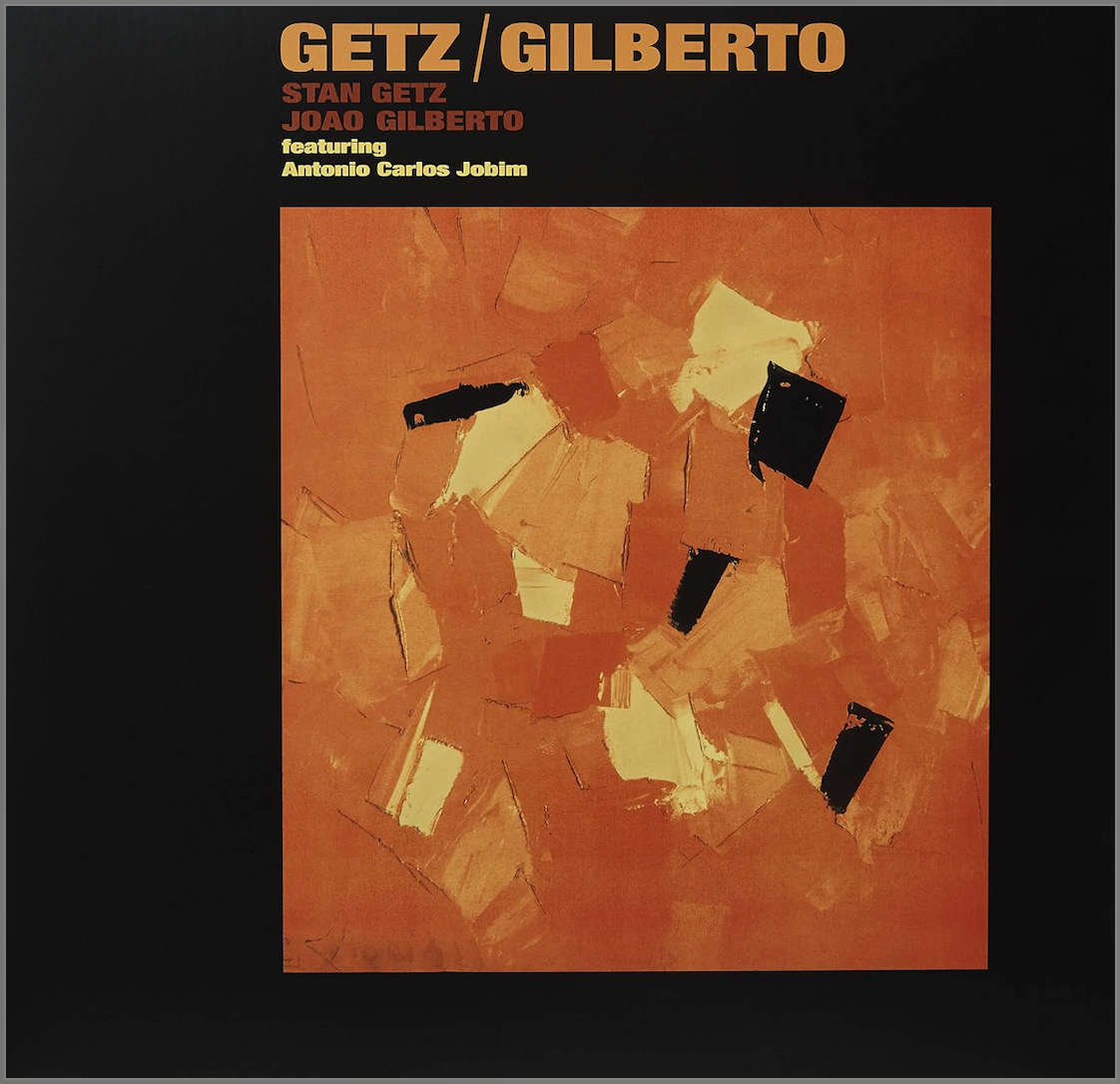
image source: Wikipedia
- Stan Getz – Tenor Saxophone
- João Gilberto – Guitar, Vocals
- Antônio Carlos Jobim – Piano
- Sebastião Neto – Double Bass (credited as Tommy Williams due to label restrictions)
- Milton Banana – Drums
- Astrud Gilberto – Vocals on “The Girl from Ipanema” and “Corcovado”
Recorded over two days in March 1963 at A&R Recording Studios in New York City, Getz/Gilberto was released in 1964 by Verve Records.
This album helped popularize bossa nova worldwide and introduced Brazilian music to American audiences in a big way. Featuring Antônio Carlos Jobim’s compositions and arrangements, the album seamlessly blended Brazilian rhythms with jazz harmonies.
The recording included classic tracks such as “The Girl from Ipanema” and “Corcovado (Quiet Nights of Quiet Stars),” both of which have become bossa nova and jazz standards.
- The Girl from Ipanema
- Doralice
- Para Machucar Meu Coração
- Desafinado
- Corcovado (Quiet Nights of Quiet Stars)
- Só Danço Samba
- O Grande Amor
- Vivo Sonhando
Reception and Impact
Getz/Gilberto was both a critical and commercial success. It won the 1965 Grammy Award for Album of the Year, the first time a jazz record received the honor, and also took home awards for Best Jazz Instrumental Album and Best Engineered Recording.
The album’s success extended beyond jazz audiences, making it a crossover sensation and inspiring countless covers and interpretations. Its minimalist, airy feel and infectious groove made it a timeless classic.
Why It’s On This List
Getz/Gilberto is considered one of the greatest jazz albums of all time and the definitive bossa nova record. It is one of the few albums that sparked a global fascination with Brazilian music.
source: Wikipedia
26. Pat Metheny Group – Still Life (Talking) (1987)
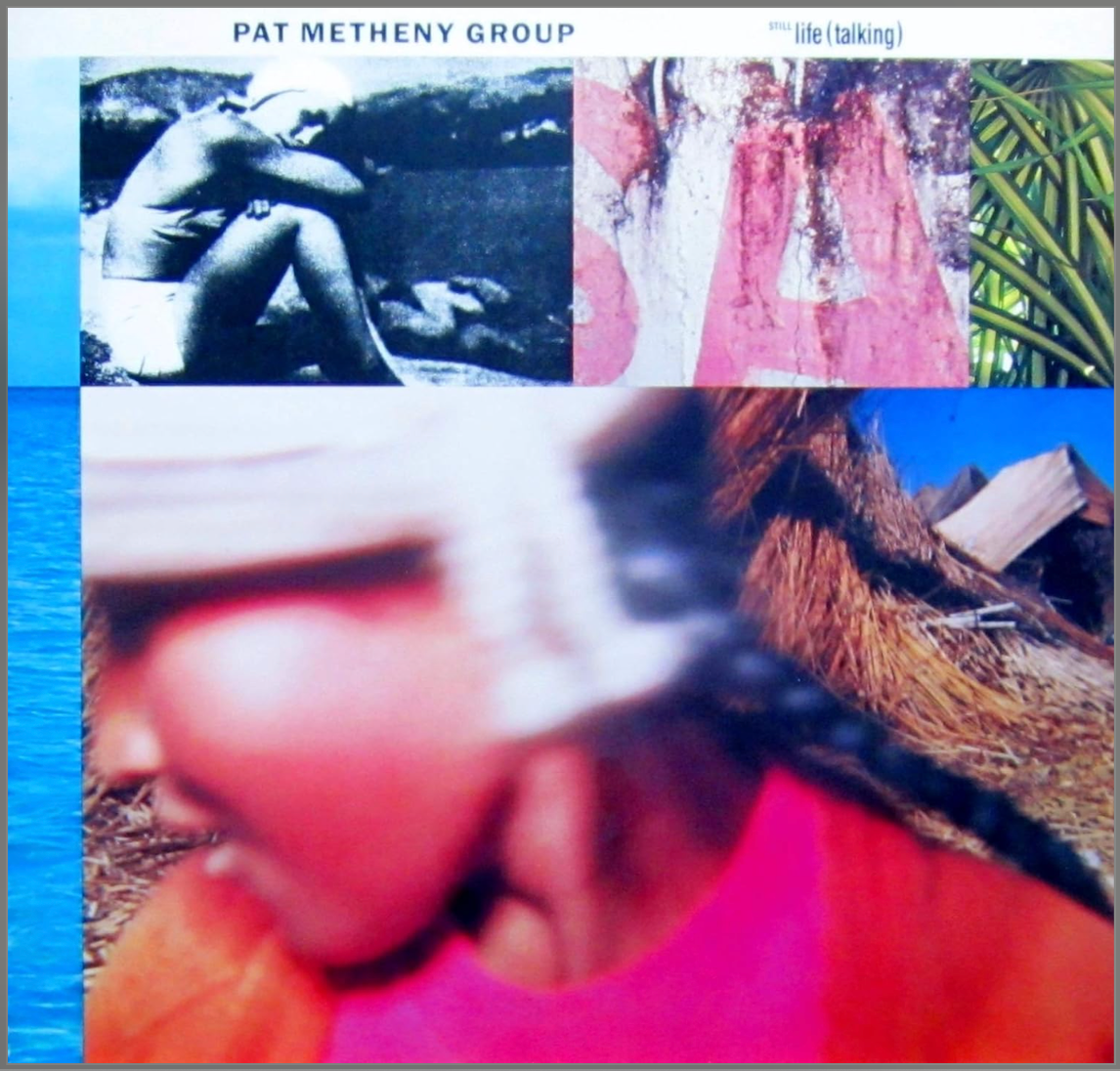
image source: Wikipedia
- Pat Metheny – Acoustic and Electric Guitars, Guitar Synthesizer
- Lyle Mays – Piano, Keyboards
- Steve Rodby – Acoustic and Electric Bass
- Paul Wertico – Drums
- Armando Marçal – Percussion, Backing Vocals
- Mark Ledford – Vocals
- David Blamires – Vocals
Still Life (Talking) is a groundbreaking work in the jazz fusion genre and an important milestone in Pat Metheny’s career. Released in 1987, it seamlessly blends jazz, Brazilian, and world music to create a new sound.
- Minuano (Six Eight)
- So May It Secretly Begin
- Last Train Home
- (It’s Just) Talk
- Third Wind
- Distance
- In Her Family
Reception and Impact
The album received widespread critical acclaim and commercial success. In 1988, it won the Grammy Award for Best Jazz Fusion Performance, solidifying the Pat Metheny Group’s reputation as a pioneer in modern jazz fusion.
Still Life (Talking) reached No. 1 on the Billboard Jazz Albums chart and was noted for its crossover appeal, drawing in listeners beyond the traditional jazz audience. Its blend of genres made it a groundbreaking release, adding to Pat Metheny’s reputation as a genre-defying artist.
Why It’s On The List
Still Life (Talking) remains one of the most celebrated albums in the Pat Metheny Group’s discography and is repeatedly cited as one of the best jazz fusion albums ever. It set a new standard for what was possible in contemporary jazz.
source: Wikipedia
27. Thelonious Monk – Genius of Modern Music: Volume 1 (1956)
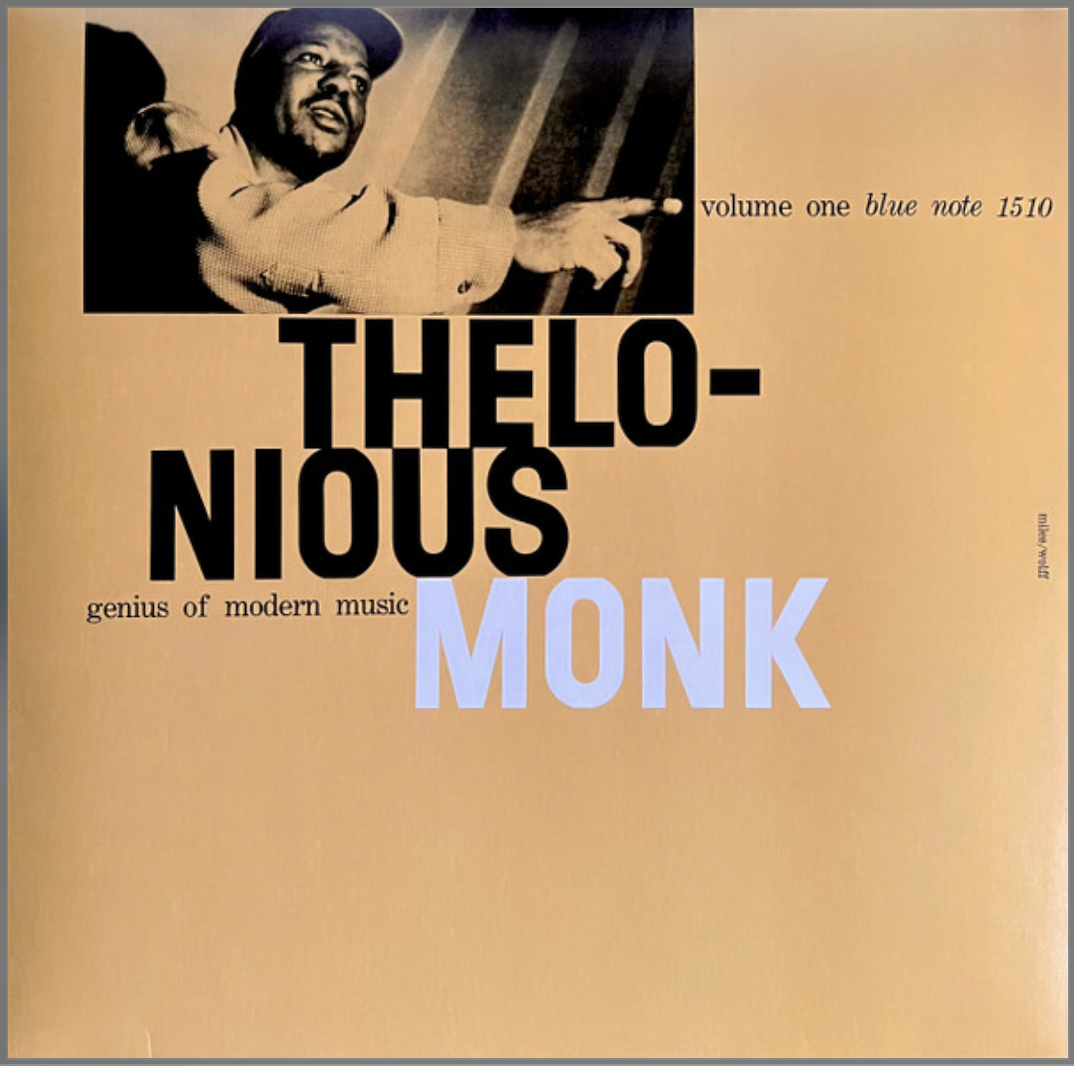
image source: Wikipedia
- Thelonious Monk – Piano
- Idrees Sulieman – Trumpet (selected tracks)
- Danny Quebec West – Alto Saxophone (selected tracks)
- Gene Ramey – Bass
- Art Blakey – Drums (selected tracks)
- Milt Jackson – Vibraphone (selected tracks)
- John Simmons – Bass (selected tracks)
- Shadow Wilson – Drums (selected tracks)
Thelonius Monk’s music was incredibly important for the development of jazz’s harmonic, rhythmic, and melodic language. That’s why I’ve selected an important compilation album to represent his music.
Initially recorded in 1947 and 1948 and released by Blue Note in 1956, Genius of Modern Music: Volume 1 features some of the earliest and most influential recordings of Monk’s music.
The album features classic recordings of Monk’s music, such as “Round Midnight,” “Well You Needn’t,” and “Ruby My Dear,” which are all part of the standard repertoire.
- Round About Midnight
- Off Minor
- Ruby My Dear
- I Mean You
- April in Paris
- In Walked Bud
- Thelonious
- Epistrophy
- Misterioso
- Well You Needn’t
- Introspection
- Humph
Reception and Impact:
The album received a mixed reception upon release. Jazz critics found Monk’s unorthodox playing and harmonic approach challenging to comprehend. However, the hostile jazz critics failed to grasp just how important Monk’s music and philosophy would be to the jazz world.
Over time, however, Genius of Modern Music has been recognized as a document of Monk’s early genius and an essential work in the development of modern jazz. Today, the album is considered essential listening for understanding the evolution of jazz piano and composition.
Why It’s On The List
Genius of Modern Music: Volume 1 is a vitally important work highlighting Monk’s early development as a composer and pianist. The album’s reissues, including expanded CD editions, have made it a must-have for jazz enthusiasts and musicians alike.
Its influence is still felt in contemporary jazz circles, crystalizing Monk’s reputation as one of the most influential figures in jazz history.
source: Wikipedia
28. Clifford Brown & Max Roach – Clifford Brown & Max Roach (1954)
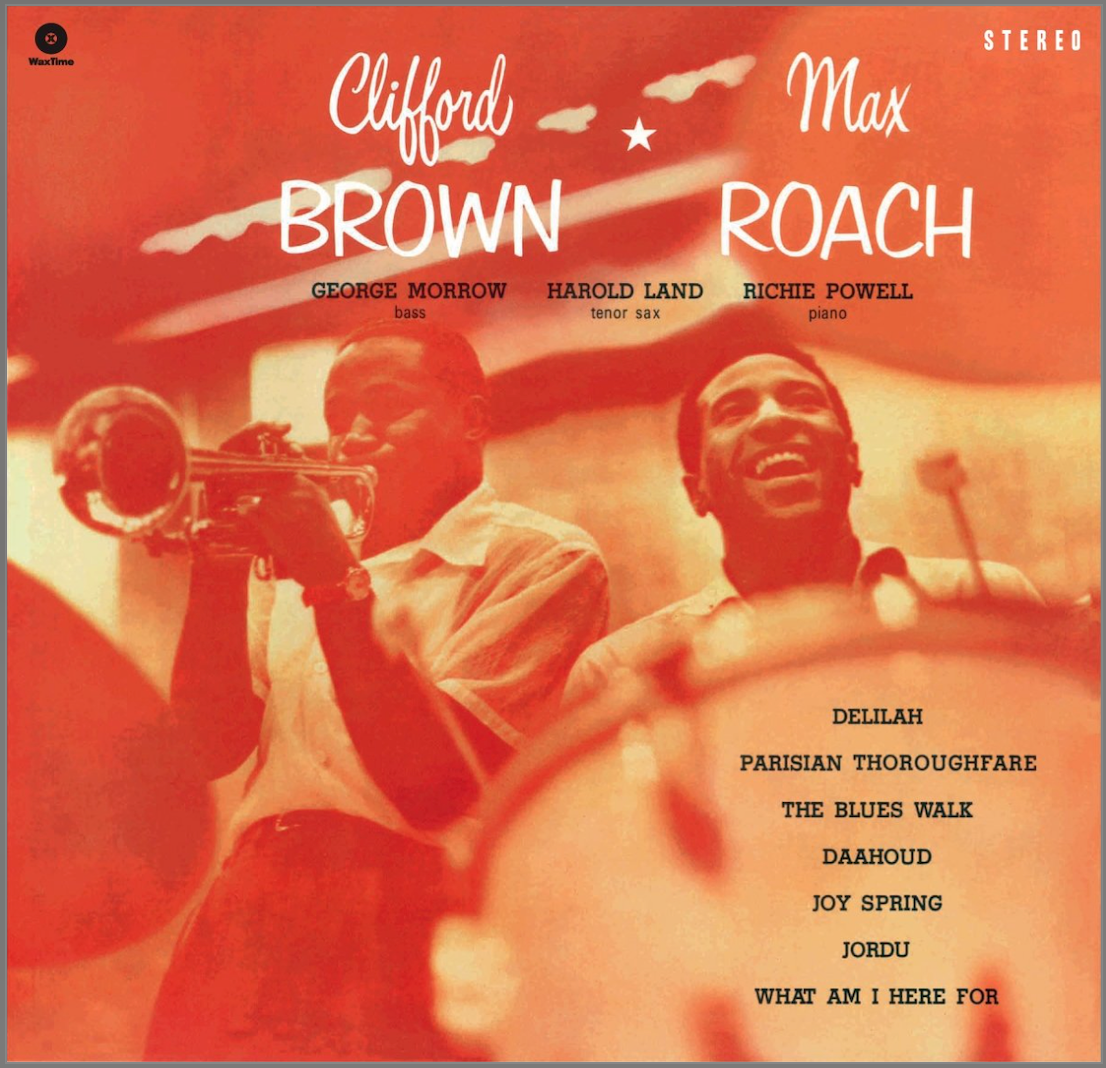
image source: Wikipedia
- Clifford Brown – Trumpet
- Max Roach – Drums
- Harold Land – Tenor Saxophone
- Richie Powell – Piano
- George Morrow – Bass
Released in December 1954 by EmArcy Records, Clifford Brown & Max Roach is an essential album for exploring the evolution of bebop and hard bop.
It features a quintet led by trumpeter Clifford Brown and drummer Max Roach, who joined forces to form one of the most influential, if short-lived, groups of the 1950s.
The album highlights Brown’s brilliance as a trumpeter and composer and Roach’s innovation in drumming.
The sessions that produced this album marked the debut of the group’s “classic quintet” lineup, with Harold Land on tenor saxophone, Richie Powell (brother of the amazing Bud Powell) on piano, and George Morrow on bass.
Its tight arrangements, sophisticated compositions, and high-energy performances.
- Delilah
- Parisian Thoroughfare
- The Blues Walk
- Daahoud
- Joy Spring
- Jordu
- What Am I Here For?
Reception and Impact
This great jazz album has been praised for its virtuosic playing and innovative jazz compositions. In 1999, it was inducted into the Grammy Hall of Fame.
This album is often cited in lists of the greatest jazz albums and was considered by The New York Times as “perhaps the definitive bop group” until Clifford Brown’s tragic death in 1956.
Why It’s On The List
Despite its relatively brief existence, the Clifford Brown and Max Roach Quintet had a lasting impact on jazz, setting new standards for composition and group interplay.
source: Wikipedia
29. Charlie Parker – Ornithology: The Best Of Bird (Compilation)
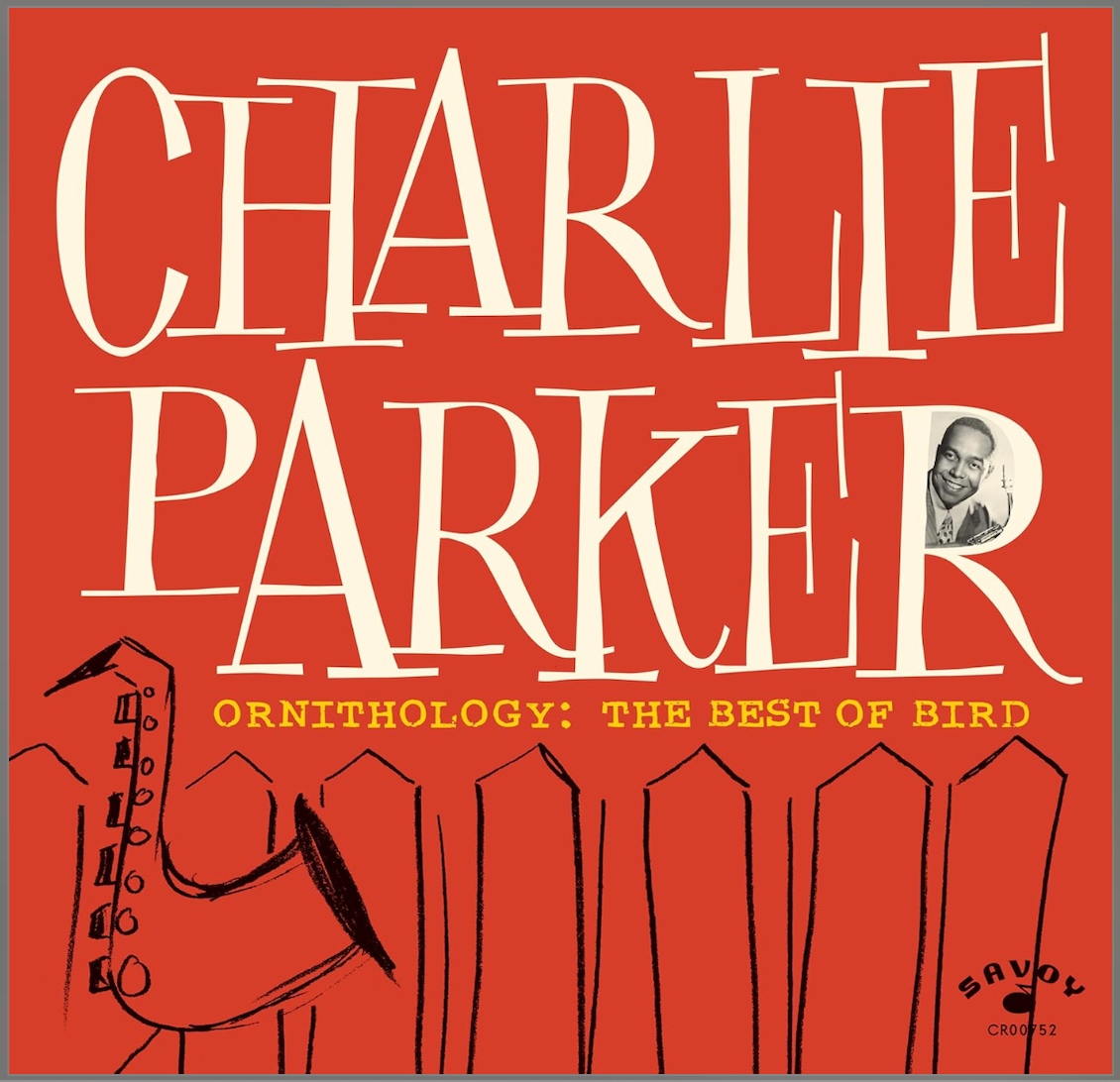
Let’s explore a compilation album for perhaps the best jazz musician to ever grace us with 8th notes. I chose a compilation album because taking a tour of Parker’s work is extremely important for anyone interested in understanding the development of jazz.
Charlie Parker was the first jazz musician to codify what we now know today as bebop vocabulary. There are clear distinctions in jazz language pre and post-Bird. To learn more about the elements of jazz language, check out this article on 20 jazz licks.
This compilation album features quintessential Bird recordings that reveal Charlie Parker’s virtuostic genius. It’s an important chapter in jazz history that any jazz fan needs to study!
- Ko-Ko
- Now’s The Time
- Cheryl
- Parker’s Mood
- Billie’s Bounce
- Donna Lee
- Confirmation
- Ornithology
- Groovin’ High
- Anthropology
- Salt Peanuts
Why It’s On the List
Charlie Parker’s influence on jazz is immeasurable. He shaped not only the evolution of jazz but also impacted the work of writers, visual artists, and musicians in multiple genres.
This compilation album isn’t particularly unique in and of itself. Any solid compilation album will do. The more important takeaway is that jazz fans need to listen to Charlie Parker and his work however they can get it. This album offers a great way to do that.
source: Wikipedia
30. Ella Fitzgerald and Louis Armstrong – Ella and Louis
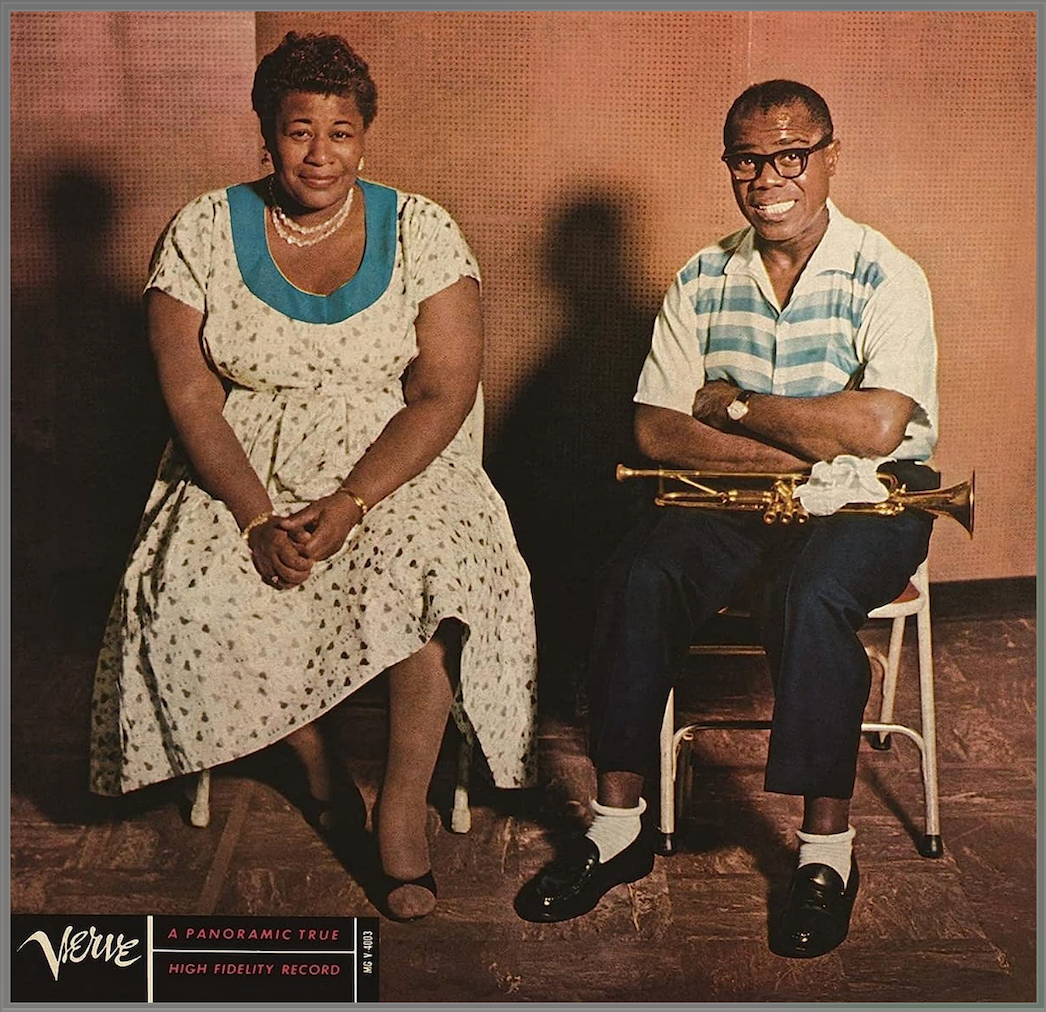
image source: Wikipedia
- Ella Fitzgerald, Louis Armstrong – Vocals
- Louis Armstrong – Trumpet
- Oscar Peterson – Piano
- Herb Ellis – Guitar
- Ray Brown – Bass
- Buddy Rich – Drums
Ella and Louis was recorded on August 16th, 1956, and released that October. It features an all-star line-up of jazz legends, including Ella Fitzgerald, Louis Armstrong, Art Tatum, Herb Ellis, and Oscar Peterson. It is one of the most significant examples of a vocal jazz album with crossover popular appeal.
The Oscar Peterson Quartet was hired as the backing band for Ella Fitzgerald and Louis Armstrong. To learn more about other jazz legends, check out our article on the 16 most famous jazz musicians of all time.
- Can’t We Be Friends?
- Isn’t This a Lovely Day?
- Moonlight in Vermont
- They Can’t Take That Away from Me
- Under a Blanket of Blue
- Tenderly
- A Foggy Day
- Stars Fell on Alabama
- Cheek to Cheek
- The Nearness of You
- April in Paris
Reception and Impact
Upon release, Ella and Louis reached No. 1 on the Billboard Jazz Best Seller list and peaked at No. 12 on the mainstream chart. The collaboration led to two more albums: Ella and Louis Again (1957) and Porgy and Bess (1958).
Why It’s On This List
This album exhibits the contrasting styles of Ella’s refined tone and Armstrong’s gravelly, playful approach. The chemistry between the two jazz singers and their improvisational playfulness makes it an irresistible favorite among jazz fans.
Ella and Louis is cited as one of the greatest jazz vocalist albums ever.
source: Wikipedia
Check Out The Learn Jazz Standards Inner Circle To Take Your Jazz Playing to The Next Level
Are you interested in learning how to play jazz but don’t know where to start? The Learn Jazz Standards Inner Circle is designed to help you overcome practice plateaus and take your jazz playing to the next level.
Ready to become a better jazz musician?
Improve in 30 Days or Less. Join the Inner Circle.



